

Jeff Thomson: Values and Culture Matter Most Capital Planning with Emergence-Focused Analytics Scale Up Smarter JANUARY 2023 LEADERSHIP STRATEGIES FOR ACCOUNTANTS AND FINANCIAL PROFESSIONALS PREPARE FOR CFOs 2023
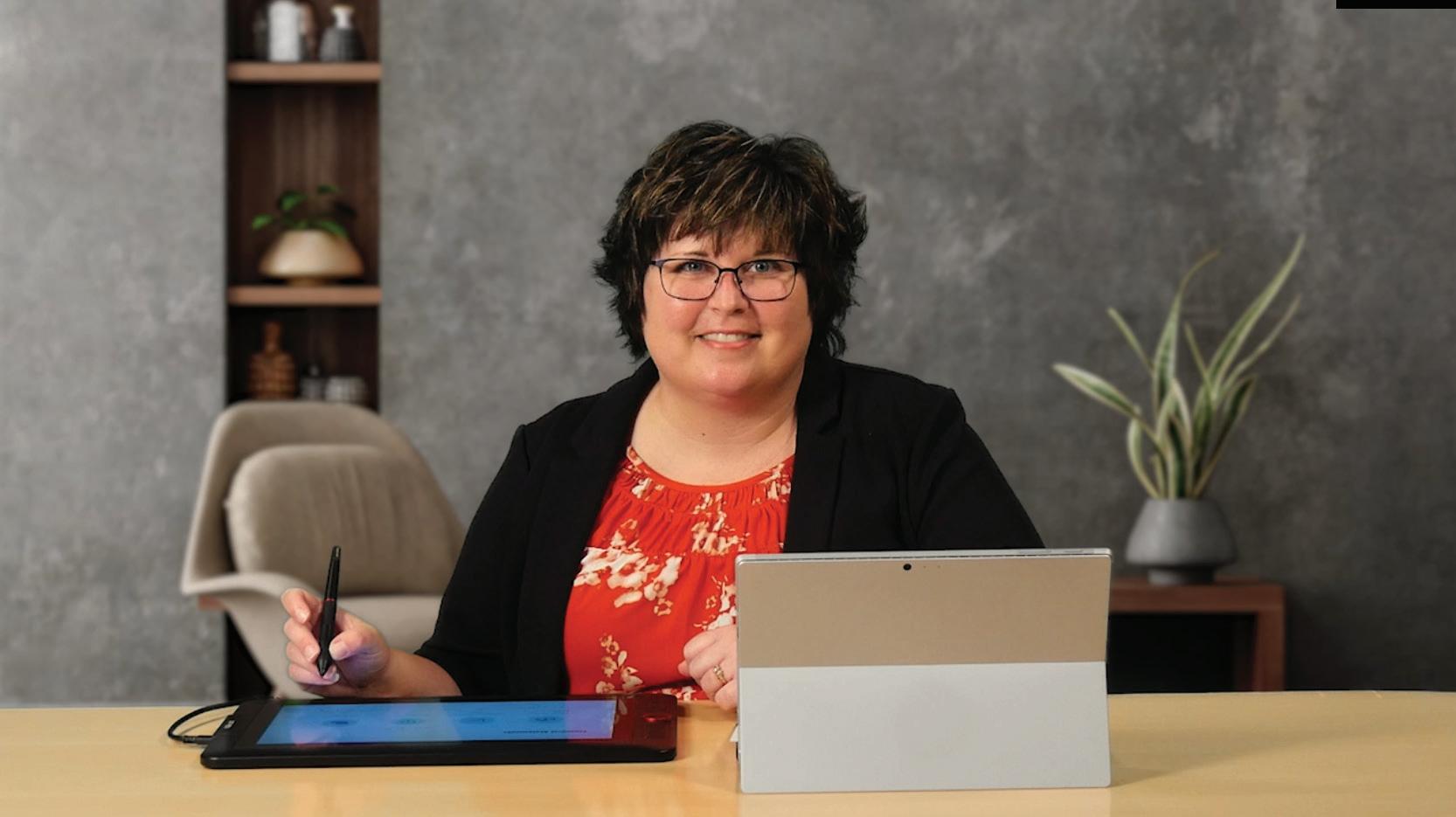

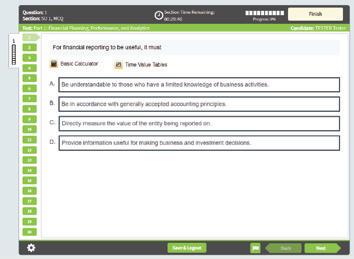
The new year looks to be as challenging and volatile as 2022. CFOs and their companies will face a range of issues, from inflation and weakened consumer confidence to the continued growth of data volume and hybrid work environments.
 BY DANIEL BUTCHER
BY DANIEL BUTCHER
JEFF THOMSON: VALUES AND CULTURE MATTER MOST
As president and CEO of IMA, Jeff Thomson led a turnaround that doubled the organization’s membership, expanded its international presence, and marked the award of the 100,000th CMA certification.
BY LORI PARKS
CAPITAL PLANNING WITH EMERGENCEFOCUSED ANALYTICS
Managing the uncertainty of capital project portfolios requires a responsive approach.
SCALE UP SMARTER
BY
ADAM DU PON, PH.D., CMA, AND HARI RAMASUBRAMANIAN, PH.D., CMA, CA
Knowing how and when to expand the business requires a flexible execution strategy that fits the business market. An approach aimed at self-sustainability will address many factors, like getting the right team and culture in place and properly managing cash.
BY DAVE HARUTIAN
FEATURE ARTICLES January 2023 / STRATEGIC FINANCE / 1 CFOs PREPARE FOR 2023
COVER STORY
26 Heading into 2023, CFOs are focused on macroeconomic trends, supply-chain issues, sustainability, evolving technology, and more. Contents /1.23 26/ 34/ 42/ 50/
READ STRATEGIC FINANCE ARTICLES FOR
CPE CREDIT:
IMA CPEdge Express™ offers courses based on articles from IMA’s award-winning Strategic Finance magazine, in an online, interactive self-study format. IMA members can earn CPE credits by answering a few online review questions and completing and passing a final assessment.


IMA CPEdge Express™ qualifies for CPE credit under NASBA QAS certification. For more information, go to bit.ly/3eDEv8G

PERSPECTIVES 6 STANDING UP FOR WHAT’S RIGHT BY GWEN VAN BERNE, CMA TOP LINE 8 TREASURED MEMORIES BY JEFFREY C. THOMSON, CMA, CSCA, CAE SF BULLETIN 10 IMA: WELCOME, NEW CMA s! 10 NEWS : IFAC RELEASES REPORT ON CORPORATE EMISSIONS 11 NEWS : FASB SEEKING COMMENTS ON PROPOSED NEW CHAPTER OF CONCEPTUAL FRAMEWORK 11 IMA: WELCOME, NEW CSCA s! 12 BOOKS : HELP TO REINVENT YOUR ORGANIZATION 12 SURVEY: TURBULENT TIMES Authorization to photocopy Strategic Finance. Items for internal or personal use, or the internal or personal use of specific clients, is granted by IMA to libraries and other users registered with the Copyright Clearance Center (CCC) Transactional Reporting Service, provided that the base fee of $3.00 per copy, plus 30¢ per page, is paid directly to CCC, 222 Rosewood Drive, Danvers, MA 01923. (www.copyright.com) ISSN 1524-833X, $3.00 + 30¢. For reprint information, contact: Alice Schulman. Phone: (201) 474-1547. Email: aschulman@imanet.org For permission to make 1-50 copies of articles, contact: Copyright Clearance Center www.copyright.com TECHNOLOGY WORKBOOK 57 TECH FORUM BY MICHAEL CASTELLUCCIO 59 TOOLS OF THE TRADE BY MICHAEL CASTELLUCCIO 60 EXCEL BY BILL JELEN 62 TECH PRACTICES BY GLENN MURPHY, CMA, CFM, CPA, CIA IMA LIFE 64 MY TRANSITION TO FP&A BY WASSIA KAMON, CMA, CPA 2 / STRATEGIC FINANCE / January 2023 34 50 Contents /1.23 ETHICS 13 JOB ROTATION MAY PREVENT ACCOUNTING MISCONDUCT BY KEI TSUNODA, CMA TAXES 15 TAX YEAR 2022 FILING ISSUES BY JAMES W. RINIER, CPA, EA, AND ANTHONY P. CURATOLA, PH.D. CAREERS 17 THE RISKS OF ACCEPTING A COUNTEROFFER BY PAUL MCDONALD LEADERSHIP 19 LEADERSHIP IN THE AGE OF BIG DATA BY HANS WEEMAES, CMA, CFA STRATEGIC MANAGMENT 21 INNOVATION-DRIVEN CULTURE BY MARK L. FRIGO, PH.D., CMA, CPA, WITH E. TERRY GROFF, DARREN SNELLGROVE, AND HANS LÆSSØE
SF PICK 59

FOX MASTER OF SCIENCE IN Accounting & Financial Management • Live virtual classes • Completion pathway of less than two years • Built-in preparation for the CMA® Exam • Advanced coursework in strategic financial planning and data analytics technology • Personalized professional development resources PREPARE TO PASS THE CMA Scholarships available. Learn more at fox.temple.edu/IMA. PART-TIME, ONLINE FORMAT WITH:
EDITOR-IN-CHIEF CHRISTOPHER DOWSETT, CAE cdowsett@imanet.org
SENIOR EDITOR ELIZABETH KENNEDY ekennedy@imanet.org
SENIOR EDITOR NANCY FASS nfass@imanet.org
TECHNOLOGY EDITOR MICHAEL CASTELLUCCIO mcastelluccio@imanet.org
FINANCE EDITOR DANIEL BUTCHER daniel.butcher@imanet.org
STAFF WRITER/EDITOR
LORI PARKS lori.parks@imanet.org
SENIOR DESIGNER JAMIE BARKER jamie.barker@imanet.org
CIRCULATION ALICE SCHULMAN aschulman@imanet.org
EDITORIAL ADVISORY BOARD
Bruce R. Neumann, Ph.D. Academic Editor
Ann Dzuranin, Ph.D., CPA Associate Academic Editor
William R. Koprowski, Ph.D., CMA, CFM, CFE, CIA Associate Academic Editor
For
The R.W. Walker Company, Inc. mike@rwwcompany.com (925) 648-3101
COORDINATOR ALICE SCHULMAN aschulman@imanet.org (201) 474-1547
FOR REPRINT INFORMATION, CONTACT: Alice Schulman Phone: (201) 474-1547 Email: aschulman@imanet.org
FOR PERMISSION TO MAKE 1- 50 COPIES OF ARTICLES, CONTACT:
Copyright Clearance Center, www.copyright.com
Strategic Finance® is indexed in the Accounting and Tax Index by ProQuest at www.il.proquest.com
Except as otherwise noted, the copyright has been transferred to IMA® for all items appearing in this magazine. For those items for which the copyright has not been transferred, permission to reproduce must be obtained directly from the author or from the person or organization given at the end of the article.
Views expressed herein are authors’ and do not represent IMA policy unless so stated. Publication of paid advertising and new product and service information does not constitute an endorsement by IMA of the advertiser or the product or service.
Strategic Finance® (ISSN 1524-833X/USPS 327-160) Vol. 10 4, No. 7, January 202 3. Copyright © 202 3 by IMA. Published monthly by the Institute of Management Ac coun tants, 10 Paragon Drive, Suite 1, Montvale, NJ 07645. Phone: (201) 573-9000. Email: sfmag@imanet.org Periodicals postage paid at Montvale, N.J., and additional mailing offices.
MEMBER SUBSCRIPTION PRICE: $48 (included in dues, nondeductible); student members, $25 (included in dues, nondeductible).
ADDRESS CHANGES: Send address changes to IMA, 10 Paragon Drive, Suite 1, Montvale, NJ 07645. For faster service, please enclose your present mailing label and new address including ZIP code. You can also send address or email changes to ima@imanet.org or call (800) 638-4427 or (201) 573-9000. Members, you can also log on to www.imanet.org and update your contact information directly in the My Profile section. Please allow 6-8 weeks for the changes to be reflected in the magazine mailing label.
POSTMASTER: Send address changes to IMA, Data Entry Department, 10 Paragon Drive, Suite 1, Montvale, NJ 07645.
VOL. 104 NO. 7 January 2023
NATIONAL ADVERTISING MANAGER MIKE WALKER
4 / STRATEGIC FINANCE / January 2023
more information on the role of the Editorial Advisory Board and a complete list of reviewers, visit sfmag.link/reviewers PUBLISHED SINCE 1919








FP&A Certi cate Series Explore these and other relevant courses at imanet.org/cpe IMA CPEdge Express™ IMA Data Analytics & Visualization Fundamentals Certificate® IMA Financial Planning & Analysis Certificate™ Featured IMA e-learning courses TAKE the FUTURE head on Add value to your organization and enhance your career by strengthening the skills needed to perform your role effectively. IMA Diversity, Equity & Inclusion Practices Certificate™ Predictive Analytics in Forecasting: The Basics IMA Sustainability Business Practices Certificate™
Standing Up for What’s Right
BY GWEN VAN BERNE, CMA
Gwen van Berne, CMA, is director of finance and risk at Oikocredit and Chair of the IMA Global Board of Directors. She’s also a member of IMA’s Amsterdam Chapter. You can reach Gwen at gwen.vanberne @imanet.org or follow her on LinkedIn at bit.ly/3LVeRGM
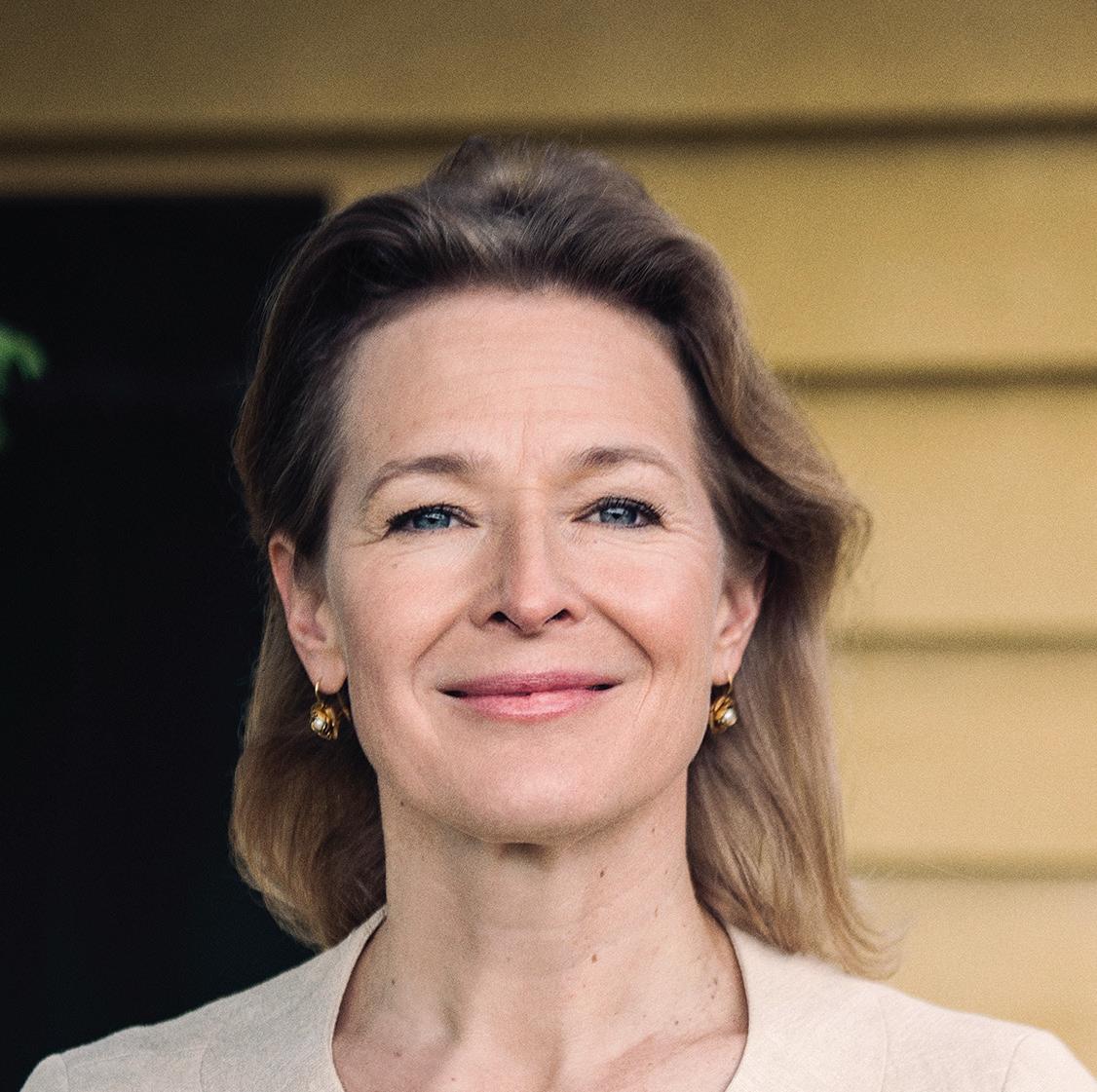
EWS OUTLETS ALL OVER THE
WORLD covered the sentencing of Elizabeth Holmes, the former founder and CEO of Theranos. After a lengthy and high-profile trial, Holmes was convicted in early 2022 on charges related to the collapse of her company, whose blood analysis technology was revealed to be largely fraudulent. In November 2022, Holmes was sentenced to more than 11 years in prison on four counts of defrauding investors, a cautionary tale on the perils of unethical behavior.
I’ve followed Holmes’s trial and subsequent sentencing closely, because about two years ago, during a panel at the IMA® Annual Conference & Expo, I interviewed Tyler Shultz, who played a key role in Theranos’s demise. Shultz, then just 22 years old, was the first whistleblower to expose the activities at the company and the underlying problem with its technology. During our interview, Shultz shared the enormous personal cost of being a whistleblower—the cost to his career, to be sure, but also the estrangement from his family, especially his illustrious grandfather, former U.S. Secretary of State George Shultz.
I was satisfied by the news of Holmes’s conviction and sentencing, as well as gratified for Shultz. He must have been enormously relieved (and he is, based on what I’ve read about his response) that his courageous action wasn’t in vain. Clearly, the U.S. courts agreed that it isn’t okay to raise money based on false scientific claims and to lie to investors with promises that can’t be kept. Fake it until you make it isn’t
acceptable, and overselling is detrimental to society and our profession because it undermines trust.
Although Shultz was a scientist and not an accountant, his actions strike at the heart of what we believe as IMA members: A commitment to act ethically must undergird all we do as accounting and finance professionals, even when it requires great cost or sacrifice. As Shultz’s example demonstrates, being critical of an organization isn’t always easy, but it’s important to trust the process and hold onto your belief that the outcome will be worth it.
Fortunately, IMA provides many valuable resources to help us strengthen our ethics muscle. Of course, we have the IMA Statement of Ethical Professional Practice (bit .ly/2OvLDCo) as well as our Ethics Helpline. IMA also makes available numerous educational courses on the subject of ethics (bit.ly/3Vfy5fL), some of which provide suggestions for helping to prevent fraud. These preventative measures include things such as: (1) setting a strong tone at the top; (2) segregating duties; (3) using an external auditor; (4) providing board of directors’ oversight; (5) reviewing inventory, journal entries, and electronic transfers; (6) implementing a reconciliation process; and (7) setting up a fraud hotline. And remember that all IMA ethics courses are free for members.
Every new year offers an opportunity for a fresh start, a chance to look back on the past with discernment and consider ways to make improvements that will lead to a more promising tomorrow. I challenge us all to look for ways to renew our commitment to standing up for what’s right, even when it causes discomfort or personal hardship. The future of our organizations, and even society, might depend on it. SF
6 / STRATEGIC FINANCE / January 2023
PERSPECTIVES
«Every new year offers an opportunity for A FRESH START.»
N
HR for businesses that want to thrive – not just survive
Struggling to keep your business compliant and competitive in changing times? Navigate business challenges with the assurance that comes from Insperity’s unmatched HR service and support.
Whether you need help keeping up with evolving labor laws, attracting and retaining diverse talent in a tight market, leading remote teams or overcoming some other HR obstacle, you can move forward with Insperity behind you.

FULL-SERVICE HR EMPLOYEE BENEFITS
HR TECHNOLOGY
Learn more at insperity.com/ima | alliance@insperity.com.
Treasured Memories
BY JEFFREY C. THOMSON, CMA, CSCA, CAE
DURING MY TENURE AS
IMA® president and CEO, I’ve enjoyed the privilege of helping this great organization accomplish some remarkable things. Although it’s difficult to name all the highlights of these 14-plus years, I count among them achievements like our reentry into the International Federation of Accountants, the continued growth of the CMA® (Certified Management Accountant) program around the world, and our sustained position as a thought leader on the most critical issues facing our profession.
welcoming people, and scrumptious food. The demand for advanced certifications like the CMA is growing at a remarkable rate in this entire region, and the team and I met with corporate entities, educational institutions, associations, and review course providers to solidify our relationships and identify new opportunities.
The trip also provided an excellent chance for IMA to showcase our thought leadership on sustainability and environmental, social, and governance (ESG) issues. During well-attended chapter events in Mumbai and Delhi, I spoke on the topic of ESG and fielded some thoughtful questions from members.
Jeffrey C. Thomson, CMA, CSCA, CAE, is IMA president and CEO. He also is a member of IMA’s BergenRocklandMeadowlands Chapter. You can reach Jeff at jthomson @imanet.org or follow him on Twitter: @IMA _JeffThomson
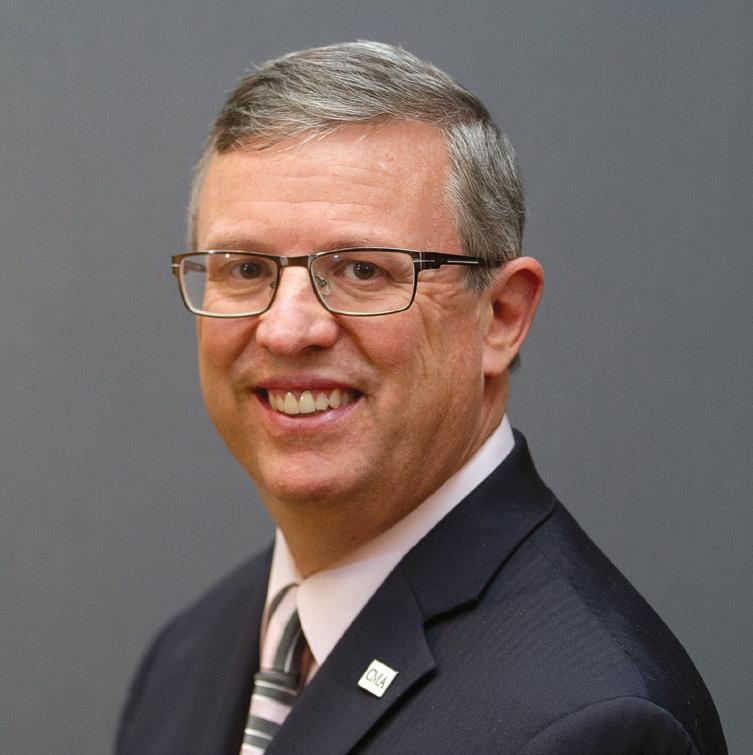
One of the elements of the job I’ve most treasured is the opportunity to travel to meet with our members, staff, and partners around the world. By my last count, I’ve made more than 50 trips outside of the United States during my time as IMA’s staff leader, to places as close as Canada and as distant as Japan. The chance to exchange ideas and witness firsthand the enthusiasm, commitment, and passion of our global IMA community always fills me with renewed energy for the work we’re doing for the profession and our members.
I had the opportunity to experience this once again during a recent trip to India, where I was grateful to travel freely after the restrictions of COVID-19 of the past nearly three years. I, along with other senior IMA staff leaders both from the U.S. and our office in India, spent more than a week in this remarkable country, which has always impressed me with its rich culture,
We were also able to participate and exhibit at the World Congress of Accountants held in Mumbai on November 18-21, 2022. Under the theme “Building Trust, Enabling Sustainability,” the conference brought together business leaders from around the globe to discuss the challenges of sustainability in our changing world and the business imperative to make such issues a priority. It was an honor to be part of a panel to discuss our research on sustainability and to meet with conference attendees at our booth, where we discussed IMA’s commitment to this pressing concern.
Given the important role that travel has played in my term as president and CEO, it’s only fitting that I end my final Top Line column extolling the joys I’ve received when I’ve ventured beyond the boundaries of IMA’s global headquarters in Montvale, N.J. I’ll carry those experiences with me for a lifetime—they’ve shaped me professionally and personally. Thank you to all IMA members and staff around the world for being part of my journey. SF
8 / STRATEGIC FINANCE / January 2023
«I’ll carry my IMA experiences with me for a lifetime— THEY’VE SHAPED ME PROFESSIONALLY AND PERSONALLY.»
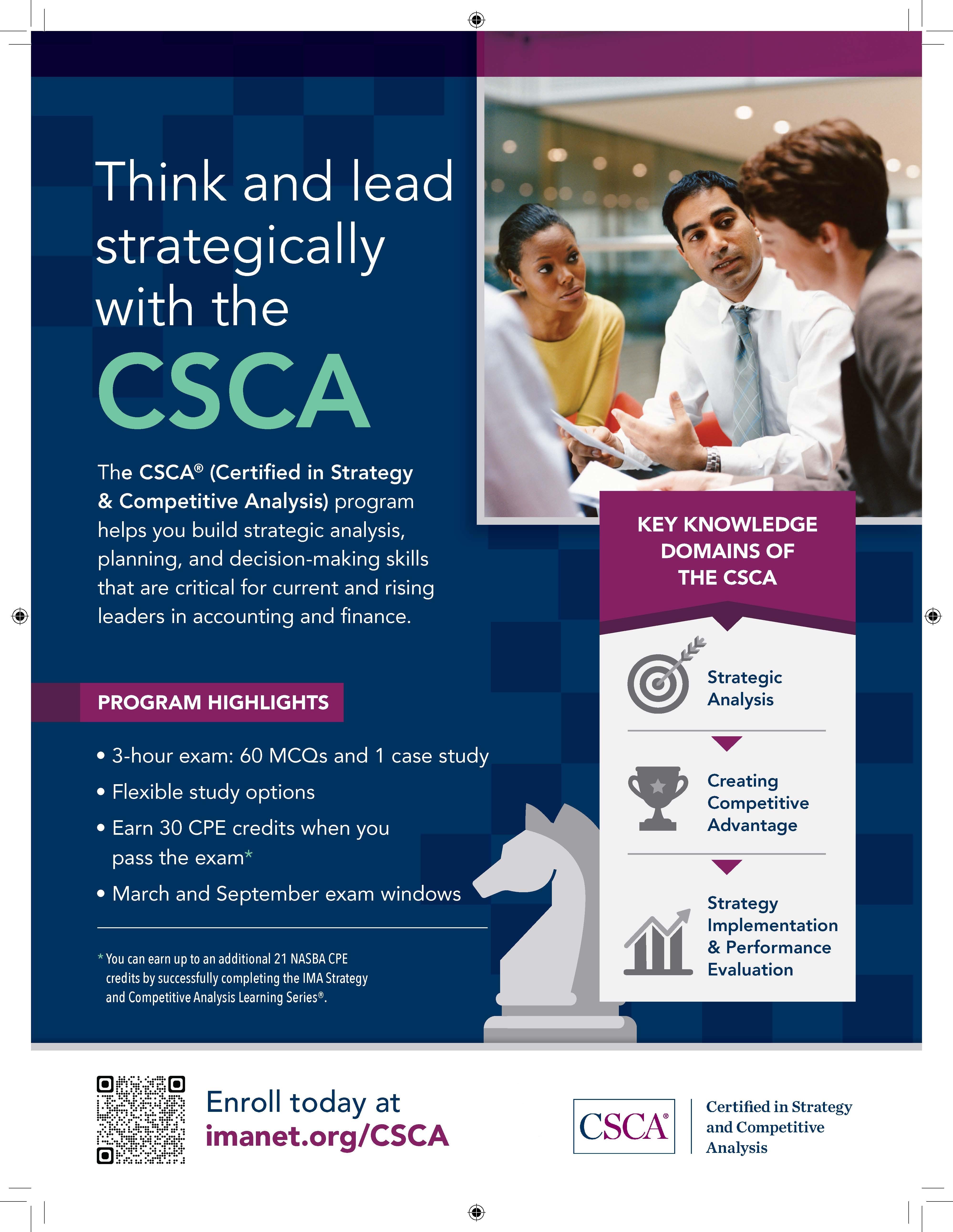
IFAC RELEASES REPORT ON CORPORATE EMISSIONS
The International Federation of Accountants (IFAC) released a report in November 2022 that focused on corporate emissions reduction reporting and found that inconsistency and incomparability of target disclosures may pose challenges for investors, regulators, and other stakeholders who require actionable information.
The findings of the report, Getting to Net Zero: A Global Review of Corporate Disclosures, support the movement in global policy toward rapidly enhancing the usefulness of disclosures on climate-related targets and transition plans.

The report is based on 2020 corporate reporting and provides a benchmark for climate disclosures that are under development by the International Sustainability Standards Board, the U.S. Securities & Exchange Commission, and the European Financial Reporting Advisory Group, among others.
The report came during the 27th Conference of the Parties to the United Nations Framework Convention on Climate Change (COP27) in Egypt, where delegates from more than 190 countries, many of which have proposed or set net-zero targets for around mid-century, gathered to discuss and advance climate actions.
“With COP27, this is [the] perfect time to dig into what is being disclosed and explore how emissions disclosures need to become more decision-useful,” said IFAC CEO Kevin Dancey. “The accountancy profession is well positioned to drive improvements in climate reporting, ensuring information is trusted and decision-useful for management and boards, investors, and all stakeholders.”
The report is available at bit.ly/3Y6GCDM Nancy Fass
10 / STRATEGIC FINANCE / January 2023 NEWS/
WELCOME, NEW CMA s ! 1,091 IMA members became CMAs between November 1 and November 30, 2022. The names of all the new CMAs can be found on the Strategic Finance website
.
more information on CMA certification, visit www.imanet.org /cma-certification .
at sfmagazine.com/issue /january-2023
For
FASB SEEKING COMMENTS ON PROPOSED NEW CHAPTER OF CONCEPTUAL FRAMEWORK

The Financial Accounting Standards Board (FASB) is seeking public comment on a proposed new chapter of its Statement of Financial Accounting Concepts No. 8, Conceptual Framework for Financial Reporting , a document that sets forth interrelated objectives and fundamentals that the FASB uses to set standards.
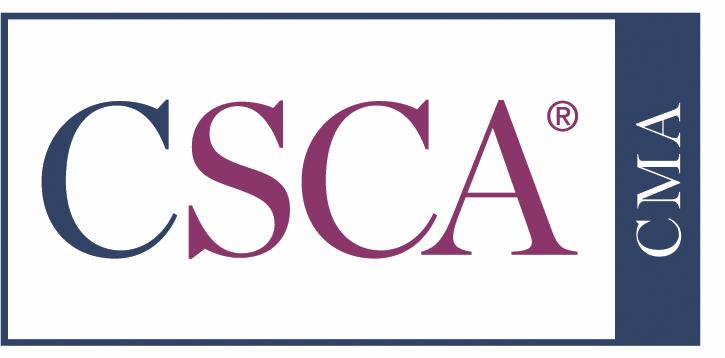
The new chapter (bit.ly/3UFBJhV) would become Chapter 5 of the Conceptual Framework and would, like the rest of that document, provide the FASB with a framework for developing standards that meet the objective of financial reporting and enhance the understandability of information for existing and potential investors, lenders, donors, and other resource providers of a reporting entity.
Specifically, the proposed chapter sets forth recognition and derecognition criteria and guidance on when an item should be incorporated into and removed from financial statements. Stakeholders are asked to provide input on the following three proposed recognition criteria an item should meet to be recognized in financial statements, subject to the pervasive cost constraint and materiality considerations:
1. Definitions: The item meets the definition of an element of financial statements.
2. Measurability: The item is measurable and has a relevant measurement attribute.
3. Faithful representation: The item can be depicted and measured with faithful representation.
The FASB also seeks stakeholder input on whether derecognition—the process of removing an item from financial statements of a reporting entity as an asset, liability, or equity—should occur when an item no longer meets any one of the recognition criteria.
Stakeholders should submit comments on the proposed chapter by February 21, 2023. —Lori Parks
January 2023 / STRATEGIC FINANCE / 11
NEWS/
WELCOME, NEW CSCA s ! 64
members became CSCAs between November 1 and November 30, 2022.
CSCAs
be
.
IMA
The names of all the new
can
found on the Strategic Finance website at sfmagazine.com/issue /january-2023
CSCA
For more information on
certification , visit www.imanet.org/csca -credential .
Bu llet in
HELP TO REINVENT YOUR ORGANIZATION
Finance leaders can team to reevaluate their organization’s strategies, capabilities, structure, culture, and management tools.
Reinventing the Organization: How Companies Can Deliver Radically Greater Value in Fast-Changing Markets by Arthur Yeung and Dave Ulrich provides timely insights into how companies can adapt to volatile market conditions and pursue opportunities with speed and scale. The authors highlight experimental and emerging organizational models, mainly drawn from the tech industry, suggesting alternatives to traditional hierarchal models.
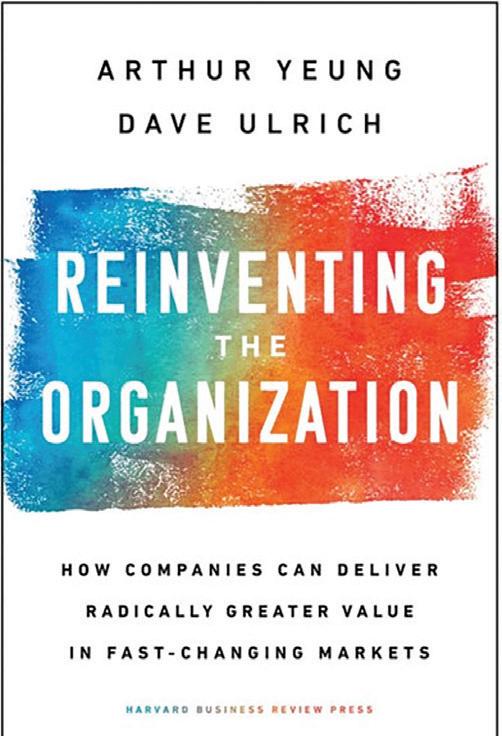
They also propose an ambitious integrated framework for organizational reinvention that encompasses strategies, capabilities, structure, culture, management tools, and leadership. Given the wide array of topics covered, this book is more of a high-level business transformation survey than an in-depth treatise. It’s an ideal overview for curious management accounting and finance professionals, regardless of whether it’s practical to implement the integrated framework fully.
Organizational reinvention is worth considering as businesses emerge from the pandemic. One of the recurring themes in Strategic Finance is the need for accounting and finance professionals to partner with their company’s CEO and other senior leaders to drive business decisions and results. For many, the COVID-19 years might be remembered for remote work from home and pandemic-related minutia; tightly controlled selling, general, and administrative (SG&A) expenses, budgets, and cash forecasts; and dynamic financial modeling. Moving forward, how can finance leaders help businesses to prepare for a post-pandemic new normal? The authors share useful answers to that question that tie into operations and strategic planning.

In chapter 2, the authors recommend an environmental, social, and governance assessment as a critical first step of reinvention, encouraging readers to “predict the evolution of your industry not from the past, but by imagining backward from the future [to] become a futurist who imagines things others don’t see [and to] constantly be looking for what is missing.” Practical suggestions on culture and collaboration are found in chapters 6 and 11, respectively. Chapter 12 includes insightful tips for the many hats that leaders wear: cultural definer, business strategist, organizational architect, and talent manager.
Yeung and Ulrich should be commended for the breadth of the topics that they cover and their suggested applications of the concepts that they present. Readers will have much to consider, including at least a few ideas that prompt immediate action. Rand N. McMullin, CMA, CPA, PMP
SURVEY/ TURBULENT TIMES
BlackLine published a white paper titled Eye of the Storm examining the role of finance and accounting (F&A) in responding to instability and volatility. Based on a survey of C-suite and F&A professionals around the world, the paper looked at the impact that today’s economic, business, and geopolitical challenges will have on business.
63 %
of all respondents said they expected a worldwide recession within a year.
95 %
of respondents expect rising interest rates to have an impact on the way their business operates. 42
%
are worried that prospects or customers will have less income to spend, which could impact sales/revenue. 41
%
are worried that the organization will face higher costs.
To learn more, download the full report at bit.ly/3Y2HxFc .
12 / STRATEGIC FINANCE / January 2023
BOOKS/
JOB ROTATION MAY PREVENT ACCOUNTING MISCONDUCT

Job rotation can help prevent or reduce the risk of fraud similar to that seen in Toshiba’s accounting scandal.
BY KEI TSUNODA, CMA
JAPANESE MULTINATIONAL CONGLOMERATE TOSHIBA CORPORATION revealed in July 2015 that it had inappropriately inflated reported profits by $1.3 billion over seven years. This scandal mainly consisted of four inappropriate accounting treatments: manipulation of the percentage-of-completion method (reporting an additional $398 million profit before tax), parts transactions in the personal computer (PC) business (reporting an additional $493 million), deferment of expense recognition (reporting an additional $73 million), and late recognition of inventory loss and intentional revision of the standard costing system (reporting an additional $300 million).
Toshiba was instructed by Japan’s Financial Services Agency (FSA) to pay a $61.4 million fine, a record high as of 2015. The FSA also issued an order to Ernst & Young ShinNihon LLC, Toshiba’s external auditor, to pay a $17.5 million penalty, imposed a ban on accepting new clients for three months, and suspended seven auditors’ CPA licenses for one year. Individual shareholders sued Toshiba executives in a $15.8 million class-action lawsuit filed in the United States for the devaluation of the corporation’s shares and securities in the wake of the scandal. This legal battle is still ongoing.
FRAUD RISK FACTORS
Toshiba’s scandal originated from a mixture of fraud risk factors.
Incentives and pressure. Toshiba’s PC business had been suffering from squeezed operating profits since 2011. The president/CEO of Toshiba put pressure on the managers in the PC business, reportedly telling them during internal meetings to do whatever they could to restore profitability.
Opportunity. The company’s internal auditing committee didn’t function properly, as it was aware of the inappropriate inflation of profits, which it referred to as “carry over.” Internal auditors should’ve demanded that management settle all inventory loss and expenses immediately but instead allowed management to defer for an entire year. Further, Toshiba’s finance officers didn’t control the reporting aptly. Instead, they took
ETHICS
January 2023 / STRATEGIC FINANCE / 13
the initiative to push ahead with the improper mandates of carry over.
Attitudes and rationalization. Tone at the top negatively influenced this improper accounting. The Independent Investigation Committee reported that two former presidents/ CEOs, Norio Sasaki and Hisao Tanaka, were not only aware of Toshiba’s carry over but actually supported it in order to show high performance with an eye toward their anticipated subsequent careers as lobbyists.
A MULTIFACETED WORK CULTURE
Japan is a consensus-driven, high-context society that values respect for seniority and intuitive, contemplative team players who are concerned with the collective. These characteristics play well when professionals need to collaborate and hustle for a shared goal. The Japanese word kaizen, which means continuous process improvement, fueled Japan’s impressive economic growth from the mid-1950s to 1973. Another example of Japanese cultural traits is a tendency toward collaboration, good manners, and sharing resources in confronting natural disasters such as earthquakes and typhoons.
These cultural characteristics do have a downside, however. A consensus-driven society discourages individuals from adopting an innovative idea that goes against the grain. The hierarchical seniority system is a hindrance to both open innovation and whistleblowing. To this day, young officers aren’t encouraged to speak up during meetings in
traditional companies in Japan. High-context culture makes many people in Japan afraid of public conflict or disagreement. Toshiba’s senior management was dominated by executives who had been working only for that company since graduation from university. This mentality of valuing seniority and longevity were factors pushing Toshiba’s junior finance personnel to agree to perpetrate improper accounting at the urging of the company’s leaders.
THE BENEFITS OF JOB ROTATION
Toshiba’s Independent Investigation Committee suggested several direct countermeasures: (1) clarify the responsibility of senior executives involved in inappropriate accounting treatments, (2) define the responsibility of all personnel involved, (3) transform the mindset of top management, (4) abolish the topdown budgeting approach, (5) reform corporate culture, and (6) reform all accounting policies and enforce rigorous application of the new procedures.
As indirect countermeasures, the committee proposed that Toshiba (1) establish a new, enhanced internal control department, (2) enhance the board of directors’ internal control function, (3) reinforce the audit committee’s internal control function, (4) establish and communicate the details of a whistleblower system to employees, (5) increase the number of outside directors and revise its member structure, and (6) implement job rotation.
IMA ETHICS HELPLINE
For clarification of how the IMA Statement of Ethical Professional Practice applies to your ethical dilemma, contact the IMA Ethics Helpline.
In the U.S. or Canada, dial (800) 245-1383. In other countries, dial the AT&T USA Direct Access Number from www.business.att.com /collateral/access.html, then the above number.
The IMA Helpline is designed to provide clarification of provisions in the IMA Statement of Ethical Professional Practice, which contains suggestions on how to resolve ethical conflicts. The helpline cannot be considered a hotline to report specific suspected ethical violations.
Japanese companies conduct job rotation not just within a single department but across the entire company. Under such a membership employment system, every full-time employee is supposed to change jobs approximately every three years. Regularly conducted job rotation for finance staff could’ve increased the possibility of a newcomer to the department speaking up, likely helping the company’s leaders to identify and root out the fraud earlier.
In Japan, most financial institutions run a job rotation system in part as a mechanism to identify employees’ embezzlement or other misdeeds early and deter misconduct. One Tokyo-based bank makes newcomers immune from responsibility if they expose any sort of fraud within three months after being hired.
This system encourages Japanese people taught to defer to authority figures by their consensus-driven, seniority society and high-context culture to have the courage to point out unethical conduct. The job rotation system is a supplementary way to strengthen internal controls and ensure that an organization complies with the standard of integrity and prevents fraud instead of relying on an individual’s pluck to blow the whistle on misconduct. SF
Kei Tsunoda, CMA, is a manager at a multinational chemicals company in Japan, a member of IMA’s Committee of Ethics, and a member of IMA’s Japan Chapter. You can reach him at k.tsunoda987@gmail.com
ETHICS 14 / STRATEGIC FINANCE / January 2023
TAX YEAR 2022 FILING ISSUES
The 2022 tax filing season has begun, and there are a few updates and issues that tax preparers should be aware of that may apply to individual taxpayers. BY
 JAMES W. RINIER, CPA, EA, AND ANTHONY P. CURATOLA, PH.D.
JAMES W. RINIER, CPA, EA, AND ANTHONY P. CURATOLA, PH.D.
ALTHOUGH THE CONGRESSIONAL SESSION BEGINNING IN January 2023 may bring some new tax legislation, for now attention must be focused on the 2022 tax filing season. Taxpayers may be affected by the following issues when preparing their 2022 tax returns: contributions to an IRA or a Roth IRA, per diem rate changes, meal expense deductions, gig workers’ income and expense reporting, and claiming refunds for a deceased taxpayer. Let’s take a look at these issues that taxpayers and preparers must consider.
IRA AND ROTH IRA
Contributions to an IRA or Roth IRA can be made for tax year 2022 until April 18, 2023 (since April 15 falls on a Saturday). The maximum contribution amount for 2022 is $6,000 ($7,000 if the taxpayer is 50 or older by December 31, 2022).
It will increase to $6,500 ($7,500) for 2023. There’s no age limit for making a deductible IRA contribution, which means anyone with earned income can contribute to an IRA.
The amount deductible depends on the taxpayer’s filing status and income. The phaseout range for single taxpayers covered by a workplace retirement plan is $68,000 to $78,000.
For married couples filing jointly, it’s $109,000 to $129,000 if the spouse making the IRA contribution is covered by their employer’s retirement plan and $204,000 to $214,000 if the spouse making the IRA contribution isn’t covered by an employer’s retirement plan. It’s $0 to $10,000 if the couple is filing separately.
For a Roth IRA, the nondeductible contribution phaseout range for single and head of household taxpayers is $129,000 to $144,000. For married filing jointly, it’s $204,000 to $214,000, and it’s $0 to $10,000 for married filing separately. Contributions to a Roth IRA aren’t affected if a taxpayer is covered by an employer’s retirement plan.
PER DIEM RATES AND MEAL DEDUCTIONS
The U.S. Department of the Treasury issued Notice
TAXES
January 2023 / STRATEGIC FINANCE / 15
TAXES
TAX
2022-44 covering special per diem rates for the period of October 1, 2022, through September 30, 2023. Taxpayers claiming business expenses under the per diem method for travel within the United States in lieu of actual lodging, meal, and incidental expenses would apply the rates applicable for travel in each quarter. The applicable per diem rates for travel prior to October 1, 2022, and after September 30, 2023, in nonhigh-cost localities are $202 and $204, respectively, and, in high-cost localities, they are $296 and $297, respectively.
The portion of the rates treated as paid-for meals remains unchanged at $74 for high-cost localities and $64 for all other localities. A listing of the high-cost localities is available in Notice 2021-52 for 2022 and Notice 2022-44 for 2023.
For calendar years 2021 and 2022 only, a business owner is permitted a temporary 100% deduction for food or beverage expenses incurred or paid to a restaurant. A restaurant includes a business that prepares and sells food or beverages to retail customers for immediate consumption (in other words, not a business that primarily sells prepackaged food and beverages not for immediate consumption).
The food or beverages don’t need to be consumed on the business’s premises, which means takeout meals qualify (see Notice 2021-25 for specific details).
GIG WORKERS
The growing number of gig workers is raising several questions for 2022 filings. If a gig worker is receiving payments of $600 or more for their services through a third party (e.g., Venmo, PayPal, or others) as an independent contractor, the worker will receive a Form 1099-K, which means they need to report the income. If the individual is a hobbyist, they have income but no expenses to record because the miscellaneous itemized deduction subject to the 2% floor was eliminated by the Tax Cuts and Jobs Act of 2017. Still further, if the person is an independent contractor or a business owner, they file Form 1040, Schedule C, and claim the business expenses.
These taxpayers need to be careful because they could also receive a Form 1099-NEC from their client or customer in addition to the Form 1099-K from the company they’re working for, therefore duplicating the same amount of income. Tax preparers will need to be vigilant for such
duplicated income, which means the taxpayer needs good documentation to remedy this situation.
A taxpayer may receive both a Form 1099-K and Form 1099-NEC from a company, which doesn’t represent double-counted income. For example, Uber and Lyft drivers will receive a Form 1099-K for commissions earned and a Form 1099-NEC for bonuses or referrals earned during the year. In these cases, the income isn’t duplicate.
FORM 1310
In the case of an individual claiming a refund for a deceased taxpayer, Form 1310, Statement of Person Claiming Refund Due a Deceased Taxpayer, may need to be filed with the Internal Revenue Service (IRS) to claim the refund. Specifically, this applies in the case of a married couple who files a timely joint return that’s due a refund but then one of the spouses dies after filing and before the IRS issues the refund. When the IRS learns of the death of one spouse, it may request the surviving spouse to file a separate Form 1310 before issuing the refund.
The Form 1310 instructions don’t address this situation. It appears instead in the detailed letter sent by the IRS (IRS Letter 12C notifying the taxpayer that more information is needed to process their individual income tax return) to request the surviving spouse to submit the form by mail or fax and attach a copy of the death certificate to get the refund.
The Form 1310 instructions, however, advise taxpayers not to attach the death certificate but to keep it for the taxpayer’s record. Obviously, it’s best to follow the instructions in the IRS letter, but don’t expect the check right away since it’s a paper submission.
TAX PREPARER PENALTIES
With the legislation enacted over the past few years and the introduction of new tax reporting forms and checkboxes (virtual currency transactions ), tax preparers need to be more vigilant when working with clients. The importance of documentation can’t be overstated given the increased number of tax preparer penalties, including, for example, the accuracy-related penalty for understating the taxpayer’s tax liability (the greater of $1,000 or 50% of the client’s fee ). This all adds up to another challenging year as taxpayers strive to file their taxes without running afoul of the abundant tax pitfalls. SF
James W. Rinier, CPA, EA, is a former assistant clinical professor of accounting and an alumnus of Drexel University. He can be reached at jwr29@dragon .drexel.edu
Anthony P. Curatola, Ph.D., is editor of the Taxes column for Strategic Finance, the Joseph F. Ford Professor of Accounting at Drexel University, and a member of IMA’s Greater Philadelphia Chapter. You can reach Tony at curatola@drexel.edu
© 2023 A.P. Curatola
16 / STRATEGIC FINANCE / January 2023
PREPARERS NEED TO BE MORE VIGILANT THAN EVER WHEN WORKING WITH CLIENTS.
THE RISKS OF ACCEPTING A COUNTEROFFER
While your employer may do all it can to keep you when you attempt to resign, there are a few things to keep in mind before deciding to stay with the company.
BY PAUL MCDONALD
CANDIDATES SIT FIRMLY IN THE DRIVER’S SEAT IN THE current job market, making it easier for finance professionals to find new roles that offer better pay, benefits, advancement opportunities, remote work options, and more. Research by Robert Half has found that 88% of workers feel confident about their skills and marketability (bit.ly/3VfaHPP), and, according to the U.S. Bureau of Labor Statistics, there’s still more than one job opening for every person seeking new employment.
But managers also understand the reality of the job market. Since losing their top performers is a recurring problem, they may not let you leave your current role without making a strong effort to keep you.
After you hand in your notice, don’t be surprised if you receive a generous counteroffer that may include a higher salary, more paid time off, or expanded perks. But beware—these deals are oftentimes too good to be true. They might seem attractive on the surface, but accepting them may prove to be risky.
The following are a few reasons why you might want to think twice before accepting a counteroffer and staying with your current employer.
Your employer might question your loyalty. Announcing your intention to resign can irrevocably change the way your employer thinks about you. If you accept a counteroffer and remain at the company, management may begin to question your loyalty, seeing you as someone who isn’t fully invested in the organization’s success.

This puts you in a precarious position. If there’s a promotion available, you might be passed over because leadership isn’t sure of your commitment. Furthermore, if the company is forced to lay off employees, you might be among the first to go since you’re perceived as having one foot out the door already.
You should also consider that accepting a counteroffer will affect
CAREERS
January 2023 / STRATEGIC FINANCE / 17
your relationships with your coworkers. They may feel like you’ve received special treatment and may become resentful. This can create a difficult work environment and may even undercut your effectiveness on the job.
Counteroffers rarely solve underlying problems. While a salary boost may be tempting, it won’t fix what’s already broken. If you’re feeling underappreciated and overworked at times, you will probably still feel that way even if you’re making more money. Likewise, if you feel out of sync with your teammates or your company’s organizational culture, a raise won’t make those issues disappear.
Before jumping to accept a counteroffer, take a step back and think about why you wanted to leave in the first place. Unless you can say with certainty that an increase in pay or other benefits will solve the issues that drove you to look for new opportunities, it’s likely best to move on.
Rejecting a new job offer could burn bridges. With high inflation and an uncertain economic outlook, a substantial counteroffer can be especially appealing. But a potential consequence of accepting a counteroffer is hurting your career prospects. If you rescind an already accepted offer from a new employer, it’s unlikely this employer will give you a second chance if you’re still unhappy a few months later.
That company invested time and effort in recruiting you, an investment it
will have to repeat with someone else if you turn down the offer.
Accepting the offer could alter your own perceptions. A counteroffer isn’t the same as a promotion. Even if you agree to a higher salary and attractive new perks and benefits, your job title and core responsibilities will likely remain unchanged. This has the potential to cause friction in your own attitude toward your coworkers, especially if their behavior toward you changes, as previously mentioned.
You’ll also likely find yourself less invested in your position. While temporarily it might be nice to receive a higher salary and more perks, the core problems will remain unchanged, and you’ll likely find your passion and motivation slipping.
It could be a while before you get another raise. Finance and accounting salaries are trending upward as companies compete for top talent and employees switch jobs in droves. Indeed, Robert Half’s 2023 Salary Guide found that 82% of senior managers have given raises to employees who expressed salary concerns (bit.ly/3QDE241).
If you accept a counteroffer now, how strong will your negotiating position be when you ask for a raise next year? The answer will vary depending on the attitude of your employer.
If the employer has come to view you as a flight risk, you may find your pay eventually falling behind that of colleagues who are viewed as more loyal and committed.
HOW TO MOVE ON THE RIGHT WAY
When you’ve made up your mind to leave, it’s important that you do it the right way. Be sure to tell your manager first, don’t burn any bridges, and don’t leave your team in the lurch. It’s far from ideal, for example, to quit your job in the middle of a big project. Support coworkers who will be taking on your responsibilities, and offer to help train your replacement if one is lined up ( bit.ly/3X0rLdu ).
Communication with your soon-to-be-former coworkers won’t likely cease the moment you leave your position. If you’re remaining in the same industry, your paths will continue to cross, and souring a relationship on the way out will only make things more difficult for you later on. Furthermore, in tight-knit industries, leaving your employer on
bad terms could lead to ill feelings with your manager that might be spread among leaders in the profession.
Be a resource for your company on your way out, and you’ll start the next leg of your career journey on the right foot. This is a courtesy you would wish for yourself should you have an employee under you resign. As a resource for your employer, you’ll aid the success for anyone stepping into your role, which will certainly be looked upon favorably. This will aid in quelling any negative feelings associated with your departure. Accept the counteroffer, on the other hand, and you risk stalling your career journey. SF
Paul McDonald is a senior executive director at talent solutions and recruiting firm
Robert Half and a member of IMA. You can follow him on LinkedIn, bit.ly/3oj8PGf
18 / STRATEGIC FINANCE / January 2023
CAREERS
THINK ABOUT WHY YOU WANTED TO LEAVE IN THE FIRST PLACE. UNLESS YOU CAN SAY WITH CERTAINTY THAT AN INCREASE IN PAY OR OTHER BENEFITS WILL SOLVE THE ISSUES THAT DROVE YOU TO LOOK FOR NEW OPPORTUNITIES, IT’S LIKELY BEST TO MOVE ON.
LEADERSHIP IN THE AGE OF BIG DATA

As the workplace has become more democratized and reliant on data analytics, the demands on leaders continue to evolve.
BY HANS WEEMAES, CMA, CFA
THERE ARE MANY ATTRIBUTES AND SKILLS THAT DEFINE A GOOD LEADER. One skill that has become essential for management accountants in the age of Big Data is the ability to bring together relevant information and individuals trained in data analytics to generate timely insights. A good leader creates the right conditions under which management can make better-informed decisions. This means ensuring not only that the right operating and governance structures of information generation, communication, and decision making are in place and functioning as intended but also that individuals work in a culture that supports collaboration and the exchange of information and ideas.
The CFO and senior accounting managers have a particularly important role in managing the flow of internal information. The ability to rapidly turn data into financial insights can help inform a range of decisions, including with respect to budgeting and strategic planning. Good leaders recognize the opportunities and risk management advantages of well-functioning information systems and data analytics, including the ability to recognize red flags and inefficiencies.
Effective finance leaders also need to be good internal networkers who can highlight the financial implications of operational and strategic decisions. Moreover, they take the initiative by detecting patterns in data, anticipating emerging issues, and performing scenario planning to keep tabs on stale assumptions and potential blind spots.
Good leaders recognize that these activities work well when they’re supported by a culture of collecting, analyzing, and sharing relevant information. Instilling a strong information culture starts with the tone and behavior of senior finance leaders. How leaders communicate data to stakeholders and use analytics to make decisions sends a clear message throughout the business about the importance of data in operational and strategic matters.
Taking interest in the work and ideas of employees at different levels, not just direct reports, also helps finance leaders build trust and provides an opportunity to reinforce
LEADERSHIP January 2023 / STRATEGIC FINANCE / 19
the organization’s core values and ethical standards.
FINANCE LEADS THE WAY
Management accountants have no shortage of opportunities to demonstrate leadership and their abilities in data management, governance, and analytics. Demonstrating a high degree of competence in a particular skill such as financial planning and analysis is one way to provide leadership.
Finance professionals can demonstrate leadership by sharing technical accounting knowledge, making an information process more efficient, analyzing and presenting data to reveal a new pattern or insight, or discovering or creating a new data visualization tool that helps management understand the business better.
Another way to show leadership is to act as a connector who can synthesize various sources of information. For example, a finance analyst might recognize that an action in one department might have implications for another and work to quantify and communicate the financial impact. Making these types of connections can reveal opportunities that may be valuable to the company’s senior management and board of directors. Serving as a bridge between those who are comfortable with data analytics and those who aren’t can also represent a chance to lead within an organization.
Understanding the C-suite’s big-picture priorities may trigger specific ideas for how to support those initiatives through specific projects, training,
or resources. Moreover, acting like a leader also means anticipating what’s coming around the corner, e.g., working backward from a deadline or anticipating what a client might want or will likely need.
When unanticipated issues arise, being able to use analytic frameworks to break a problem into parts, use data to understand the problem better, articulate what resources you need, and calmly work through the problem to find a solution rather than reacting to it impulsively is a great way to show leadership.
More generally, adopting a curious mindset, showing initiative, and committing to continuous improvement and learning will set a good example and create leadership opportunities regardless of your current job title or level of experience.
CULTURAL ELEMENT OF LEADERSHIP
A shift toward a more democratic, less hierarchical leadership culture is an emerging global trend. Good leaders recognize that insights come from all levels and that every team member has an important contribution to make. This is especially the case in the age of Big Data, where the increasing complexity of various factors that inform decisions may favor flat team structures and collaboration.
In this environment, good leaders build a culture of trust and serve as facilitators of employees’ success. They ensure that team members have a seat at the table and are comfortable voicing their opinions and exchang-
SF ADVICE
IMA LEADERSHIP ACADEMY
The IMA® Leadership Academy supports the development and enhancement of our members’ leadership education and skills to aid in career advancement. From presentation of or participation in leadership courses offered in person or virtually to our community of experienced leaders through our mentoring program to IMA’s leadership recognition program where members can measure their development and earn digital badges, the IMA Leadership Academy can help you meet your leadership goals. For more information, please visit the Leadership Academy website at www.imanet.org /career-resources/leadership -academy.
ing feedback, as well as encourage them to consider each other’s ideas and play devil’s advocate when appropriate. Even the most junior member of the team armed with a fresh idea, perspective, or analysis can be influential and make valuable contributions in a democratic leadership culture.
MAKE TIME FOR MENTORSHIP
The value of mentorship can’t be overstated. Management best practices are absorbed on the job by working with colleagues in leadership roles. Most good leaders have learned from other good leaders who took the time to provide advice and training during their formative years. My advice for junior professionals is to find good mentors and be open to asking for—and receiving—feedback.
Similarly, my advice to more experienced professionals is to pay it forward by making time for mentorship. Simple routines such as regular check-ins providing informal feedback and career advice or including junior staff on client calls can make a big impact on colleagues’ professional development. Providing internal training and knowledge-sharing programs is another valuable way to demonstrate leadership and show commitment to the professional development of team members. SF
Hans Weemaes, CMA, CFA, is a director and head of economics and data analytics at Vincents. You can reach him at hweemaes@vincents.com
LEADERSHIP 20 / STRATEGIC FINANCE / January 2023
.au
INNOVATION-DRIVEN CULTURE

Developing a culture that prioritizes innovation is the key to creating long-term sustainable value.
BY MARK L. FRIGO, PH.D., CMA, CPA, WITH E. TERRY GROFF, DARREN SNELLGROVE, AND HANS LÆSSØE
INNOVATION IS WHAT DRIVES VALUE CREATION FOR companies and their customers, employees, and other stakeholders. In today’s economy, a company can’t be excessively bureaucratic and hope to be successful in value-creating innovation. Organizational culture needs to be innovation-driven and entrepreneurial for a company to create long-term sustainable value. According to continuing research at the DePaul Strategic Risk Management Lab using the life-cycle framework, the hallmark of a failing business model stage is business-as-usual complacency and an excessively bureaucratic culture that works against innovation.
How can CFOs, finance and management accounting professionals, and board members ensure that a good innovation culture exists, and how can you evaluate and improve innovation culture in an organization? Let’s begin by defining innovation culture and then consider three companies, Reading Bakery Systems, Johnson & Johnson, and the LEGO Group, with leaders who can share insights on developing an innovation-driven culture.
WHAT IS INNOVATION CULTURE?
Innovation culture is a logical process that defines the way people think, act, and communicate to achieve successful value-creating innovation. The way people think determines their actions; their actions determine the success or failure of the company; and the way people communicate determines how well the company can articulate and execute on its innovation strategy effectively and efficiently.
Jim Collins, author of the book Good to Great , describes how great companies have disciplined people, disciplined thought, and disciplined actions. To achieve this, a common language and logic are used to develop an innovation culture. It’s important to keep the following top of mind: Innovation culture can be evaluated, and steps can be taken to develop an innovation culture. Innovation culture can be developed and learned, and CFOs, finance organizations, and board members can play a key role in this process.
READING BAKERY SYSTEMS
Reading Bakery Systems (headquartered in Reading, Pa.) is a food production systems manufacturer with four technology platforms: cracker production lines, cookie lines, fabricated chips, and baked pretzel and bread snacks. Though Reading is the number one manufacturer of pretzel and snack machinery worldwide, the organization was “going nowhere” in 2006; revenue and profits were stuck in a narrow range with no
STRATEGIC MANAGEMENT
January 2023 / STRATEGIC FINANCE / 21
significant growth for more than a decade. Chairman and CEO E. Terry Groff discusses how the company transformed its culture to be highly innovation-driven, which resulted in breakthrough performance. (For a discussion of the Reading Bakery Systems case with Groff, see the IMA webinar “Leadership Driven Strategy for High-Performance Teams,” bit .ly/3tcKMvY.)
MARK L. FRIGO: Several years ago, you were invited to attend an opening lecture in my Return Driven Strategy seminar course at DePaul University by your son, an MBA/J.D. student at DePaul, and attending that lecture led to your Changing the Way We Think ini-
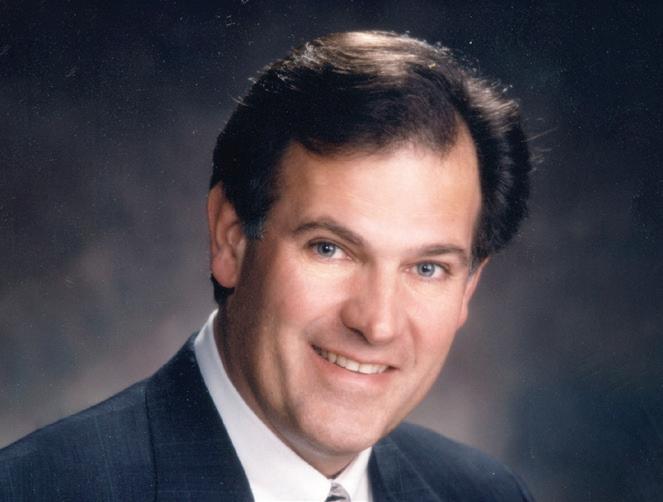

provided a logic and language for innovation culture at Reading Bakery Systems. Here are the takeaways from our initiative:
■ A common language and logic of Return Driven Strategy are used throughout the organization, which helps us develop our innovation-driven culture.
■ Key metrics are reviewed weekly and monthly; they are highly aligned with the framework.
■ We support a corporate culture in which planning and execution are prized and rewarded.
■ The Return Driven Strategy way of thinking is now part of the DNA of our organizational culture. Bottom line: We changed the way we thought about our business.
The Changing the Way We Think initiative resulted in double-digit annual growth in revenue and profits in the depth of the 2008-2009 Great Recession and throughout the next decade. It helped our company think differently about our customers.
FRIGO: Your innovation-thinking initiative at Reading Bakery Systems led to a breakthrough about thinking differently about your customers. Can you describe that shift?
power—recognizing the trend, especially among corporate buyers, who treat all buying as simply a “price exercise.” How can we differentiate ourselves from our competitors? How can we regain pricing power? Here are some of the things we did:
■ We created a separate science and innovation center to create an innovation environment where new ideas could be tested.
tiative at Reading Bakery Systems. Please share your insights.
E. TERRY GROFF: During the lecture, I could see how the framework could be applied to energize the strategy and culture at the company toward greater innovation. The next month, I invited you to present an intensive two-day workshop to the entire management team, with a pre-read of your [and Joel Litman’s] book Driven
This was the launching of the Changing the Way We Think initiative at Reading Bakery Systems. At a recent CFO Summit, I presented the keynote “How to Innovate without Going Broke” in which I described how the Return Driven Strategy
GROFF: We started thinking differently about our customers; we stopped thinking “sales territories” and replaced that with “motivation categories”; we basically had two types of customers with distinctly different motivations. For our corporate customer where the buyer is an employee, the modus operandi was “protect my job.” So we needed to market, sell, and service our offerings with an underlying “failure is not an option” strategy; for our entrepreneurial customers, the modus operandi was “protect my money”; so we developed a sales approach where we get paid from cost savings from the project, which was highly successful. We focused increased attention on customers who highly appreciate and value what we do.
FRIGO: Your innovation culture led to a breakthrough in differentiating your company through innovation. Can you describe that shift?
GROFF: We started thinking differently about creating pricing
■ We created relationships with food science programs at colleges and universities: Penn State University, Rutgers University, and University of Guelph are good examples.
■ Each year we hired a Ph.D. candidate who engaged in specific research, which resulted in a breakthrough nozzle design and breakthrough flavor chromatography, all of which had a major impact on our oven design.
FRIGO: Your experience using Return Driven Strategy thinking at Reading Bakery Systems has also been recently applied in your work as an advisor to private equity firms. Can you describe how?
GROFF: I’m still using it to help look at possible acquisition targets. The framework provides an easy, comprehensive way to evaluate a business quickly and effectively. It’s easy to see the relative strengths and weaknesses, and it provides insight into what you might need to “fix” if
STRATEGIC MANAGEMENT 22 / STRATEGIC FINANCE / January 2023
“I believe an innovation culture equals an entrepreneurial culture.”
—Mark L. Frigo
“We support a corporate culture in which planning and execution are prized and rewarded.”
—E. Terry Groff
you end up making the acquisition at private equity firms.
JOHNSON & JOHNSON
FRIGO: In our October 2016 Strategic Finance article, “Why Innovation Should Be Every CFO’s Top Priority” (bit.ly/2Qc76B8), we discussed the importance of innovation for creating value for companies, customers, employees, partners, and other stakeholders. Based on your experience at the Johnson & Johnson (J&J) Innovation division, and more recently as CFO for J&J WW Pharmaceutical Research & Development division and CFO for the overall WW Pharmaceuticals, what are the key characteristics of the organizational culture at J&J Innovation and Pharmaceuticals that make it a great model for innovation-driven culture?
DARREN SNELLGROVE: Innovation is at the heart of our mission and purpose at J&J. In J&J Pharmaceuticals, it’s all about the patients. We’re focused on bringing transformational medical innovation to patients, and that’s our foundation and what moti-
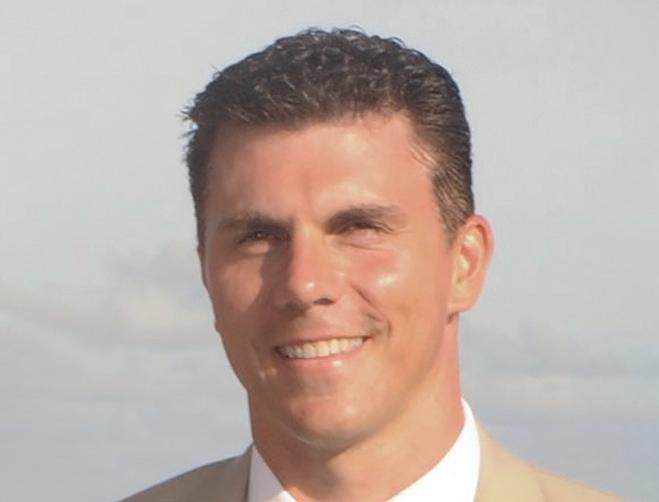
This article is part of the Creating Greater Long-Term Sustainable Value series in Strategic Finance launched by the October 2018 article “Creating Greater Long-Term Sustainable Value” by Mark L. Frigo, with Dominic Barton, bit.ly/2RfcMwm.
ership in decision analytics, pricing, cost structures, capital allocation, etc., in the most efficient and effective way we can. So, we’re highly motivated by that sense of purpose.
FRIGO: From your experience, what advice would you give to CFOs and finance and management accounting professionals in developing and supporting an innovation-driven culture in the finance organization?
SNELLGROVE: An innovation culture needs to be deeply ingrained, and it must start with the fundamentals. First, you need a clear and unwavering mission: At J&J, that’s transformational medical innovation for patients, and we ensure our finance mission is aligned. Second, you need great talent. In this case, that’s highly competent finance professionals who can perform timely, thought-provoking analysis to influence business decisions. You must develop, measure, and reward innovative (value-creating) behavior, teams, and individuals.
invest accordingly. At J&J, we firmly believe (and our results bear out) that if we create value for patients, we’ll create value for shareholders.
FRIGO: From my research on high-performance companies, we note how companies often lose their entrepreneurial spirit and become bureaucratic, which works against value-creating innovation. On a 1-to-10 scale, we evaluate how bureaucratic vs. entrepreneurial (innovative) a company’s culture is. How would you define that at J&J Pharmaceuticals? What are the characteristics you look for in evaluating the innovation culture of a company J&J partners with?
vates us every day. Innovation is our top priority. That culture of innovation within the business is infectious. In finance, that means we always want to ensure that we’re as innovative as our partners, and we aim to provide the very best financial lead-
Third, you must try to allocate as much time and energy as possible to the most value-creating activities in support of your mission. This requires, for example, efficient and effective financial systems and processes to take care of your core operations. Fourth, you must have a set of principles from which to operate. At J&J, those principles are outlined in our credo. Importantly, the credo for us starts with patients so that our principles and mission are connected. The credo is also central to our decision making; we continually reference it as we make important decisions.
Fifth, and perhaps most important of all, you must have a deep understanding of what creates value and
SNELLGROVE: J&J is built on a foundation of innovation. It’s a huge company, and that allows us to have tremendous global reach and impact. But innovation at scale is no easy task. Our approach is to remain agnostic to source. We innovate internally, but we also source innovation externally through collaborations with thought leaders, entrepreneurs, and various partner companies. Big companies can get bureaucratic, so we try to continually check ourselves and refine our processes to ensure that we can also move with speed and agility. In healthcare, we’re dealing with patients’ lives, so we must always make disciplined, data-driven decisions. Perhaps industry-specific, but it’s important to point out that slow doesn’t always amount to less innovation. In R&D [research and development], true innovation is often slow; true breakthroughs can take decades.
What we can do to speed things up is to do the killer experiments early so that we can fail fast. That way, we don’t spend too much time and money
January 2023 / STRATEGIC FINANCE / 23
“An innovation culture needs to be deeply ingrained, and it must start with the fundamentals.”
—Darren Snellgrove
on nontransformational projects. In business development, we often talk about going slow to then go fast. Getting diverse input into critical decisions ahead of time can be time-consuming but allows you to move quickly when it’s time to strike and execute on a deal. Sometimes the right level of rigor and process at the right time can
this better?” Innovation goes way beyond products and concept—it encompasses all processes and activities throughout the company, and that was/is very much the case at the LEGO Group. One small example: The iconic LEGO 2x4 brick, which has been around since the 1950s, is still being worked on for improvement. The LEGO Group has people working on how to improve stability, sustainability, quality, and cost efficiency on this as well as all other bricks.
FRIGO: What are the characteristics you look for in evaluating the innovation culture of a company?
KEY INSIGHTS
■ Innovation culture can be assessed, learned, and developed.
■ Return Driven Strategy thinking can be used to develop an innovation culture in a company.
■ Innovation culture practices from the LEGO Group and Johnson & Johnson can be adapted to develop your company’s unique culture.
actually increase speed. The key is to not let process stifle the underlying innovative spirit of the company, but rather to enhance and maximize its impact. When we evaluate external opportunities, we look for partners with similar priorities and principles: a patient-first mentality, a high bar for innovation, uncompromising ethics, and a successful track record. We look for opportunities to enhance the impact of our partners’ innovation(s).
THE LEGO GROUP
FRIGO: It’s been 10 years since we did our 2012 Strategic Finance article “Strategic Risk Management at the LEGO Group” (bit.ly/34EZGOO). What are the characteristics of the organizational culture at the LEGO Group that make it a great model for innovation-driven culture?
HANS LÆSSØE: Well, first and foremost, it’s a culture of noncomplacency. Even the most wellestablished processes and methodologies are addressed based on “What would it take for us to do
LÆSSØE: Innovation, in my perspective, is the ability to improve whatever you do. This can, as stated, be a product, a methodology, a process, or a way to organize or delegate power of authority. I’ve seen great examples of innovation in corporate finance processes, just to mention one potentially unexpected area. When I look for innovation characteristics in an organization, I look for three things: (1) a systematic drive for improvement; (2) a no-blame culture; and (3) a will to experiment and learn from both positive and negative outcomes.
FRIGO: I believe an innovation culture equals an entrepreneurial culture. Can you state some diagnostic questions boards of directors and executive teams should ask to ensure that a good innovation culture exists?
LÆSSØE: If by “entrepreneurial,” you mean a culture with a “focus on value creation,” I agree with your “formula.” If I were to interview a board of directors or management teams with the purpose of gauging their innovation culture, I would probably ask:
1. When did you last promote an employee who did an experiment that failed but taught you valuable lessons?
2. How often do you take a deliberate look at “the way you do things” and ask if this can/could be done better? (By the way, this is also embedded in the Lean concept of process thinking.)
3. Is your level of product and concept development above industry standards, and how?
FRIGO: Innovation culture can be assessed, learned, and developed, and Return Driven Strategy thinking can be used to develop an innovation culture in a company as shown at Reading Bakery Systems. For the way forward for CFOs and finance organizations, use a framework like Return Driven Strategy to evaluate and develop the innovation culture at your company. And lead the way by developing an innovation culture in your finance organization. SF
Mark L. Frigo, Ph.D., CMA, CPA, is the cofounder of the Center for Strategy, Execution and Valuation and the Strategic Risk Management Lab in the Kellstadt Graduate School of Business at DePaul University and Ezerski Endowed Chair of Strategy and Leadership Emeritus in the Driehaus College of Business at DePaul. You can reach Mark at mfrigo @depaul.edu
E. Terry Groff served as chairman and CEO of Reading Bakery Systems. You can reach Terry at terrygroff@mac.com.
Darren Snellgrove served as CFO at Johnson & Johnson Innovation, and more recently as CFO for WW Pharmaceutical Research & Development and now as CFO for WW Pharmaceuticals. You can reach Darren at dsnellg1@its.jnj.com
Hans Læssøe has 35 years of industry experience from the LEGO Group covering a wide range of positions. You can reach Hans at hl@aktus.dk
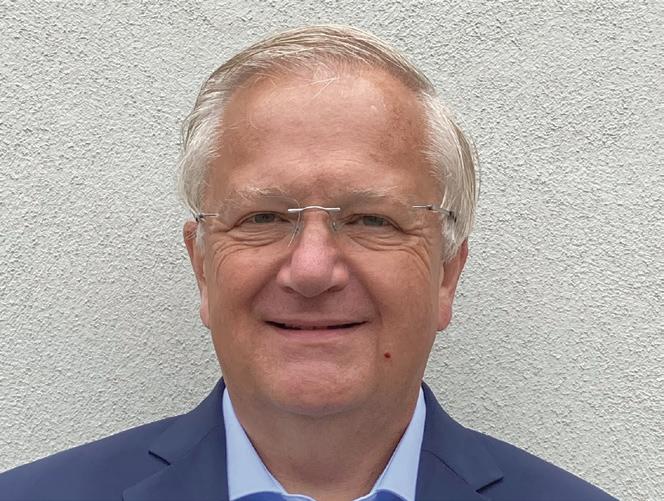
24 / STRATEGIC FINANCE / January 2023
“Innovation goes way beyond products and concept.”
—Hans Læssøe








IMA CPEdge Express™ Visit myima.org/CPEdgeEX to get started Stay current on relevant management accounting topics while earning NASBA CPE credits. This subscription package offers courses based on articles from IMA’s award-winning Strategic Finance magazine. Each course is a quick 0.5 CPE credit. New courses will be added regularly. NASBA CPE to fi t your schedule
 BY DANIEL BUTCHER
BY DANIEL BUTCHER

January 2023 / STRATEGIC FINANCE / 27
FOR Heading into 2023, CFOs are focused on macroeconomic trends, supply-chain issues, sustainability, evolving technology, and more.
PREPARE
2023
CFOs
Management accounting and finance leaders face a plethora of challenges heading into 2023, from the continued effects of the COVID-19 pandemic—including the lingering impacts on health and wellness issues—and various geopolitical conflicts to repeated interest rates increases as central banks combat inflation. All those factors affect the finance function and organizations’ budgetary priorities and strategic planning. During tough times, it becomes even more important for CFOs and other senior finance executives to display strong, effective leadership.
The third-quarter 2022 Global Economic Conditions Survey (GECS) from IMA® (Institute of Management Accountants) and ACCA (Association of Chartered Certified Accountants) found that accounting and finance professionals’ global confidence rose slightly after dropping significantly in the second quarter of 2022, but all other indicators gauging the overall performance of the global economy were far gloomier (bit.ly/3doZc2U). Customers’ and suppliers’ fear indices measuring concern that respondents’ employers may go out of business were basically unchanged, remaining above pre-pandemic levels.
Regionally, confidence in North America remained historically weak despite a slight improvement, whereas the effects of the continuing war in Ukraine, including rising gas and electricity prices, are continuing to put a damper on confidence in Western Europe. The Middle East and South Asia region was the only one to report an improved number of new orders.
Rising costs, inflation, and market volatility all continue to sap confidence worldwide and prevent the global economy from improving, according to GECS. Those headwinds and other trends will impact CFOs at companies around the world. CFOs will need to adjust their teams’ and organizations’ tactics and strategy in response to such challenges, making difficult choices and seeking opportunities for increased efficiency, innovation, and growth despite various hurdles.
Challenges on the Horizon
Steve Priest, CFO of eBay, singles out the macroeconomic environment as the biggest challenge that eBay leadership anticipates for the company in 2023. From the conflict in Ukraine to rising interest rates, major events and trends around the world combine to ultimately have a tremendous impact on not only consumer confidence but also the levels of discretionary spending that individuals have across the major markets. CFOs must adjust their internal directives so that their finance personnel react promptly and appropriately to external factors.
“For us at eBay, it’s making sure we navigate that effectively and put adequate plans in place to drive operational efficiencies in the short term to bolster the financial architecture of our company, but as importantly, to continue to
invest in the future to drive our longer-term strategic goals,” Priest says. “I always think about this concept of balance, which is keeping a very strong hand on the tiller to make sure that we navigate these choppy waters, but at the same time, leaning in, as we see fit, to continue to drive the investments we need for sustainable long-term growth.”
Particularly in challenging times of crisis, most organizations lean on their accounting and finance functions. Priest says that he always talks to all eBay teams, and particularly his finance people, about the importance of financial safety and integrity in challenging economic times as well as the importance of partnering with colleagues in other departments.
“We can help to advise and counsel our partners across the business, and it’s about finance having a seat at the table,” Priest says. “I always talk at length to the board of directors and the finance organization about these concepts of leaning into safety and partnership to help the company drive sustainable long-term growth.”
The biggest challenge in 2023 for Weis Markets, Inc., a Pennsylvania-based food retailer that operates 197 stores, a distribution center, a store support center, and manufacturing plants for meat processing and dairy products, is record-high inflation, which impacts the company’s business, associates, and customers. At the same time, says Michael Lockard, Weis Markets’ senior VP, CFO, and treasurer, the company continues to deal with ongoing supply-chain disruptions that result in out-of-stock items and significantly longer lead times for essential supplies and equipment orders. The retailer also faces the continuing challenge of recruiting and retaining talent in the pandemic-impacted marketplace across all its facilities.
“To address these challenges, we’re focused on improving efficiencies and our understanding of customers’ evolving needs and expectations. In addition, we continue to work on being an employer of choice,” Lockard says. “Our company has a strong balance sheet, an experienced management team, and stable third-generation family ownership, which allow us to focus on sustained long-term growth.
“We continuously reinvest in our store base, [including] new stores, remodels, store projects, [as well as] e-commerce and company-wide technologies that improve efficiencies and offer a consistently strong associate and customer experience,” he says.
Trends Continuing in 2023
Brian Wenzel, CFO of Synchrony Financial, which spun off from GE Capital and went public in 2014, notes that key challenges for CFOs will also carry over from 2022. A big one for CFOs is the continued year-to-year growth in data volume. Deriving insights from data has always been central to the role of the finance function, Wenzel says, and CFOs will continue to play a key role in data analytics by leveraging data and insights to understand all aspects of the company’s operations, not just the financial bottom line.
28 / STRATEGIC FINANCE / January 2023
A CFO’S ADVICE FOR FINANCE LEADERS
Act on available data. During a weaker economy, CFOs must become stronger decision makers and embrace an agile way of working. This includes leveraging AI, real-time data, and analytics insights to make quick decisions and then adjusting as more information becomes accessible.
Develop multiple scenario plans. Sychrony has been able to manage through multiple economic cycles, but each cycle requires different options from its leaders’ playbook. Finance executives are navigating through unique conditions and must accurately forecast what’s possible. It’s essential to prepare for various eventualities, ensuring that the organization has enough resources to navigate through a potential downturn and strategize to position it to emerge even stronger. This could mean evaluating cash flow and reserves, as well as scrutinizing accounts receivable.
Deepen cross-functional relationships. Leading during short-term turbulence and planning for long-term success mean managing across the enterprise. During market volatility, finance executives need to ensure that they’re looking at the right places to invest, from technology and talent to supply chains. Therefore, collaboration across the C-suite enables better spending decisions.
“To date, Synchrony has the largest number of accounts in our history—65 million active credit card accounts and seven trillion data points,” Wenzel says. “To make the best decisions, we need to analyze as much trend data that is available to us from both internal and external sources.”
Other companies are in a similar situation. That’s why it’s essential for the CFO to work across business lines, partnering more deeply with other executives to integrate data in a holistic manner, Wenzel says. He predicts that CFOs will be more important than ever in 2023 as they develop and maintain a data-driven culture across their enterprise, helping to drive a competitive advantage.
Another continuing trend is remote or hybrid work environments. Compared to before the pandemic, a significantly
higher percentage of the workforce has the option to work remotely in some capacity these days. According to Lockard, Weis Markets’ leadership predicts that work from home will continue to be a key driver in increased eat-at-home spending and decreased eat-away-from-home spending. It also expects increased customer adoption of e-commerce solutions and preference for a unified omnichannel experience. As a result of pandemic-related supply-chain issues, more companies are investing in end-to-end manufacturing and distribution to minimize service disruptions.
“As CFO, I work with a team that anticipates and adapts to these emerging trends—our management team understands the need to stay competitive in total compensation while offering flexibility to the entire workforce where pos-
January 2023 / STRATEGIC FINANCE / 29
Brian Wenzel, CFO of Synchrony Financial, offers the following suggestions based on the ways that his company’s leaders plan to tackle challenges in the current environment:
sible,” Lockard says. “We support these efforts by helping them set targets and goals, which factor in increased investments in talent, e-commerce, omnichannel and digital marketing, and supply-chain solutions.
“This includes analyzing available trend data and providing relevant insights to help decision makers at every level of our company,” he says. “The goal is to understand how our business is doing, identify where performance can improve, and then clearly communicate needed adjustments to achieve success.”
Priest reveals that eBay is going through a transformation that he calls “the tech-led reimagination” of the company. The goal, he says, is to take a declining business and turn it into a sustainably growing one. Strategically, he and eBay’s other senior leaders are focused on changing the financial trajectory of the business. The finance function continues to take a partnership-oriented approach and serve as a strategic advisor to the CEO and the rest of the leadership team.
“We’re leaning into what we term ‘focus categories’ and building trust on our overall platform, because we continue to create economic opportunity, particularly for small businesses and sellers on our platform, to help them grow with eBay and bring extremely strong levels of trust to eBay for the buyers who want to find unique or value items on eBay
or collectors of difficult-to-find items,” Priest says. “It isn’t about looking in the rearview mirror; rather, it’s anticipating trends, advising the rest of the leadership team, and not only helping them navigate the choppy waters ahead, but also providing insights about where we should invest and how we should go forward.”
Working to Achieve Sustainability
Sustainability is top-of-mind for CFOs due to the Paris Agreement, the European Commission’s Sustainable Development Goals, the launch of the Sustainability Accounting Standards Board (SASB) and, more recently, the International Sustainability Standards Board (ISSB), and the proposed U.S. Securities and Exchange Commission (SEC) rule changes that would require companies to include environmental disclosures in their registration statements and periodic reports.
“If you think about our impact on the planet, both from an environmental standpoint and the communities we continue to represent and serve, it’s a very important ingredient to everything we think about day-to-day at eBay,” Priest says. “It isn’t just about an initiative, but it’s really part of what we do.
“Sustainability through refurbished and pre-loved goods and thinking about our impact on the broader economy and the planet are incredibly important to us,” he says. “As we think about how we navigate our business going forward, that’s a key cornerstone of everything we continue to think about.”
While achieving sustainability is complicated, with many moving parts, Priest says that it starts in-house with a sustainable workforce that works to contribute to sustainable communities. He says he makes it a priority to ensure that there’s diversity of thought within eBay’s finance function and that the company’s employee base is representative of the communities in which it operates. He challenges his team to think more broadly beyond the numbers to evaluate the impact that the company is having on the planet.
“We think about the energy we consume at our data centers and office buildings, etc., and leaning into ensuring that we use renewable sources of energy to power the eBay footprint, and we’ve committed to a 90% reduction in [those],” Priest says. “For value-chain emissions, which for eBay is primarily emissions from the shipping of products, we’ve committed to 20% reductions in these emissions by 2030.
“Our biggest focus is eliminating emissions, but as we migrate the next few years, we’re continuing to pay to offset any remaining emissions to make sure that eBay continues to be a carbon-neutral company,” he says.
Beyond that, the CFO is charged with leading the way on sustainability from a reporting standpoint, ensuring the integrity of climate risk disclosures and compliance with any relevant standards, and charting the organization’s progress on nonfinancial metrics.
“Integrity is everything to me and eBay, making sure we take full accountability and responsibility for the impact we
30 / STRATEGIC FINANCE / January 2023
Rising costs, inflation, and market volatility continue to sap confidence worldwide and prevent the global economy from improving.
have on the communities we serve and the planet,” Priest says. “We’ll continue to be very thoughtful and be a leader in terms of our sustainability reporting, and, last quarter alone, we facilitated $33 million of contributions to charities.”
As reporting obligations increase and the investing community’s scrutiny of sustainability disclosures ramps up, eBay’s chief sustainability officer works within the finance function and across the business to make sure that the company’s nonfinancial reporting is adequate and effective.
“It’s very important for any company to think about the importance of being part of ESG [environmental, social, and governance] funds,” Priest says. “The companies that continue to lean into these items are ones that will be thought about a lot more when you’ve got investors leaning into [ESG and sustainability]—all companies have an obligation to really lean in here, and the finance function is a critical part of making sure companies do the right thing.”
As a U.S.-based publicly traded company, Weis Markets’ leadership closely monitors the evolving climate risk and ESG regulations and has committed to fully comply with any updates to those standards. Its senior management team and board of directors already integrate ESG issues into the company’s culture with a mission statement that includes being good stewards of the environment.
“We have a robust sustainability program, which started in 2008 and has resulted in reducing greenhouse gas emissions by 55%,” Lockard says. “It also helps to reduce our impact on the communities we serve and improve efficiencies that often result in significant cost reductions, as detailed in our annual sustainability report.
“Associates at every level of our company—store, supply chain, manufacturing, and support—have supported the growth of our sustainability program,” he says. “Our accounting and finance associates are now more involved in this space, particularly with the reporting of sustainability metrics and disclosures to the SEC just as they do with financial metrics and required disclosures.”
As for corporate social responsibility (CSR), Weis Markets makes substantial corporate donations to regional food banks, schools, healthcare organizations, and animal-rescue organizations. It also has a cause-marketing program where customers can donate to support designated causes at checkout, which the company supplements with corporate donations.
Synchrony’s ESG and CSR work dovetails with the company’s strategy and its financial planning and analysis (FP&A). In 2021, one of its strategic imperatives was to ensure a sustained focus on diversity, equity, and inclusion, with the rationale that progress in that area should strengthen its workforce and company culture as well as improve recruiting and retention in the tight labor markets in which the company competes for talent.
Another example is internal equity, which plays a key role in its compensation policy. Each year, Synchrony works with an independent third party to review the company’s pay equity for all employees globally with respect to base salary and bonuses controlled for variables that impact pay, including level, geography, function, and experience. The 2021 analysis identified an overall pay gap of 1% for women compared to men globally and an overall
pay gap of 0.7% or less for racial and ethnic minorities in the United States. As a result of this analysis, Synchrony invested more than $5 million in pay adjustments to meet its goal of 100% pay equity.
“Doing what’s right often reduces risks and creates opportunity,” Wenzel says. “Synchrony seeks to be transparent on ESG topics that are significant to the company and our stakeholders. We’ve published a CSR or ESG report since our inception as a stand-alone business that focuses on governance, human capital, environment, supplier diversity, compliance, and more,” he says.
Synchrony has responded to industry-based disclosure guidelines, SEC reporting requirements, and SASB standards, and last year it published its first report built around the Task Force on Climate-related Financial Disclosures (TCFD) framework. Wenzel says that the company’s ongoing efforts to meet the TCFD’s recommendations and the SASB requirements aim to provide a solid foundation for Synchrony to align with future ESG disclosure expectations and requirements, including those formulated by the ISSB.
Navigating Supply-Chain Challenges
The COVID-19 pandemic has tested every industry’s supply chain, but so has social and political unrest across the
January 2023 / STRATEGIC FINANCE / 31
Though the pandemic has heightened awareness of supply-chain disruptions, there are always pressures on supply chains.
FINDING THE RIGHT TALENT
A team with the right skills and expertise is critical to help CFOs—and their organizations— manage the challenges of 2023 and keep moving forward. So what are CFOs looking for in their accounting and finance talent? It begins with having the core financial acumen, eBay CFO Steve Priest says. The table stakes for someone coming into the accounting and finance profession is being a truly driven professional that has the right skill set to work in any type of team and any sort of company.
“What’s important to me is the ability to partner, communicate effectively, and influence other leaders in the organization, and, for me, having talent in the organization that enables that partnership and helps to facilitate change is of paramount importance,” Priest says. “And so, when I’m looking for talent to join eBay, it’s a function of [candidates] having the right financial acumen, but as importantly, if not more importantly, influencing communication skills and particularly partnering skills with the business because that will make you a stronger [professional].”
In today’s hybrid and remote work environments, it’s also important to have both hard and soft skills, Synchrony CFO Brian Wenzel says. Strong, versatile team players are more essential than ever. Working not just within one team but also across the company is now a key part of accounting and finance roles.
“Some of the skills we continue to seek are analytic, problem solving, risk assessment, collaboration, and communication skills,” Wenzel says. “All of this requires a strategic mindset and curiosity at heart.”
globe as well as the war in Ukraine. Synchrony combined the supply-chain risk management and procurement teams together under the finance umbrella to ensure that those functions are reviewing supply challenges holistically.
“Throughout the pandemic, we have been working with our suppliers to understand any supply-chain disruptions and economic volatility,” Wenzel says. “We’ve renegotiated contracts, strengthened partnerships, brought on new suppliers, and, in some cases, made future strategic commitments.”
Though the pandemic has heightened awareness of supply-chain disruptions, there are always pressures
on supply chains. Wenzel notes that CFOs need to be ever vigilant, ensuring that overall supplier risk doesn’t increase and staying ahead of any potential impacts on the business.

Weis Markets’ accounting and finance team members have worked capably in support of the retailer’s dynamic supply-chain and procurement processes. This has allowed the company to stay agile and quickly adapt to an evolving business landscape.
“We’ve streamlined our procure-to-pay cycle for vendors by reducing prior inefficiencies in due diligence setup, purchase-order creation, and invoice processing,” Lockard
32 / STRATEGIC FINANCE / January 2023
says. “We’ve also increased electronic disbursements and remittances.”
Supply-chain disruptions are ongoing due to world events and inclement weather, but Weis Markets’ leaders strive to be adaptable and provide customers with alternative product options. The retailer is also investing in software and facilities to stay ahead of the disruptions within its control.
The persistent supply-chain challenges as a result of the pandemic had a negative impact on eBay’s international business into 2022, but those effects are starting to dissipate, according to Priest. The company’s leadership predicts that those challenges will continue to subside over the course of 2023. That doesn’t mean that the global economy is in the clear, though.
“If you think about the workforce, transportation networks getting impacted, the outputs from some of the industrialized countries, the impact it had on greater China and some of those exports, that was certainly creating a challenge in terms of supply chains,” Priest says. “As the global economy slows, and we start to see rampant inflation and an increase in interest rates, and consumer demand starts to soften, the supply-chain challenges become less onerous, and so unless there are other significant blips on the horizon going into 2023, I don’t see supply-chain challenges as being as meaningful as some of the macroeconomic challenges we’re facing at a global level.”
Having said that, eBay leadership took action early in the pandemic after thinking through potential implications of supply-chain disruptions on its business. For example, as a tech company, it needs servers and access to chips, and it needs to make sure that its data centers have adequate resources.
“We got ahead of buying some of those items that we need up front and being very thoughtful about the impacts of the supply chain on the continuous planning of our business,” Priest says. “The biggest thing for us is making sure we keep the overall business safe and secure from an operating standpoint.”
Technology’s Impact on Finance
There are various ways for finance professionals to leverage technology, and many CFOs are tasked with doing cost-benefit analyses for implementing AI, automation, data analytics, and other recent advancements. There are new technologies and new applications of existing technology that crop up all the time, and it can be challenging for CFOs to keep pace.
“Often people think about technology through a customer or product lens, but we’ve actually taken that and [applied it to] tax. As we think about our obligations in indirect tax collection, like collect and remit, we’ve been using AI to basically ask, ‘What sort of product is this, and what sort of tax implications are there?’” Priest says. “For example, someone is selling a pair of boots on eBay—are they working boots or are they just casual boots? Based on the brand, the type of boot that’s bought and sold on eBay, we can identify through AI whether it’s applicable for a certain tax collection or not.
“When you’ve got 1.7 billion listings going through your platform, embracing that level of technology to simplify our processes, making sure that we’re compliant and meet all our obligations to the tax authorities, it’s been truly transformational in terms of how we think about taxes,” he says. “Every day we wake up, we think about how embracing change within technology can help our processes and make us a stronger finance department.”
At a store level, Weis Markets has invested in dual-use checkout lanes, shifted from mainly paper ads to more personalized digital marketing and coupons, and provided more e-commerce choices for its customers. This year, Lockard says, the company will realize benefits from investing in new software, including Invafresh, that will upgrade the retailer’s entire fresh-food operations life cycle. Also in 2023, Weis Markets’ Project Sunrise, which involves the implementation of Workday software, will transform its legacy human capital management and financial systems and processes, according to Lockard.
Digital technologies are transforming corporations from top to bottom, so it’s essential for all C-suite executives to have a grasp of these new systems and capabilities. And it’s especially important for the CFO, who plays such a big role in overseeing spending.
“Synchrony continues to digitally transform across the company—both in how we work and where we work,” Wenzel says. “We continue to improve our processes by increasing automation—Synchrony’s AI tools help the team spend less time prepping data and more time analyzing it.”
For example, Synchrony has created an AI bot that helps to automate part of the account reconciliation process. Every transaction within Synchrony—such as paying clients, accounts receivable, retail deposits, credit balance refunds, and so on—is now automated.
“This allows our employees to concentrate on higher value work,” Wenzel says. “AI will continue to play a key role in our process, and we’re also exploring how emerging technologies like the Metaverse and the smart cloud can accelerate innovation.”
All industries continue to grapple with global economic and societal upheaval, from the war in Ukraine and social unrest worldwide to rising interest rates and growing debt burdens. Finance leaders are tasked with gauging the potential impacts on their particular organization and industry. This unprecedented combination of factors leading to uncertainty and unpredictability is challenging CFOs to respond to massive disruptions and volatility and plan for various possible scenarios. Finance leaders will continue to apply data analytics and FP&A insights to guide their companies to invest for the long term while evaluating and reacting appropriately to short-term risks and setbacks. The best CFOs help their organization’s finance function to lead the way through choppy waters, overcoming challenges to achieve stability and sustainable success. SF
January 2023 / STRATEGIC FINANCE / 33
Daniel Butcher is the finance editor at IMA and staff liaison to IMA’s Committee on Ethics. You can reach him at daniel.butcher@imanet .org
JEFF THOMSON:
VALUES AND CULTURE MATTER MOST
 BY LORI PARKS
BY LORI PARKS
34 / STRATEGIC FINANCE / January 2023
IMA’s retiring president and CEO has led the organization through unprecedented growth and challenges—and set the stage for the future.

fter more than 14 years as president and CEO of IMA® (Institute of Management Accountants), Jeff Thomson will retire in 2023. During Jeff’s tenure, IMA has become a respected thought leader on emerging issues impacting the profession, achieved significant global expansion, partnered with leading organizations around the world, and grown the reputation of the CMA® (Certified Management Accountant) certification. A humble, inspirational leader, Jeff has guided the organization through impressive milestones and, in the last several years, unprecedented challenges. When Jeff departs IMA in the days ahead, he leaves behind an association that’s more resilient and better equipped to face the future than it’s ever been.
Learning the Slide Rule
Jeff grew up the youngest of two boys in Wayne, N.J., a middle-class suburban town. He staunchly defends his home state and bristles at criticism of it: “It’s called the Garden State after all. People have stereotypes about New Jersey because they don’t really know how much the state offers.” (Cue crashing waves in Cape May, the state’s southern tip, and serene, wooded state parks up north.)
As a child, Jeff developed an early interest in math, inspired by his father, an engineer. “He taught me how to use a slide rule, which is pretty much a lost art now,” Jeff recalls. Jeff discovered in high school that he not only enjoyed math but was also good at it, and he took the most advanced classes, including honors calculus. When it came time to apply to college, he stayed close to home, attending Montclair State University less than a half hour from where he grew up. He majored in mathematics as an undergraduate, then immediately began and completed a master’s degree program in mathematics and statistics.
The aspect of math that most appealed to Jeff was the way it honed his ability to think thoroughly and logically. But while some of his classmates were interested in the theoretical aspects of the discipline, Jeff found he enjoyed the more practical side of the subject—the way that math, as he says, “can be applied to practically anything, be it music, arts, and, of course, business.”
An Early Data Scientist
The opportunity to apply his math skills in a business setting came quickly to Jeff as he neared the end of his master’s studies. The classes in his program were small, only six or eight students, so he got to know his instructors well. One of his graduate-level professors, Tom Devlin, consulted for AT&T in Basking Ridge, N.J., and encouraged Jeff to consider a position with that company. “I interviewed for a job that was basically as a data scientist—although at the time, they didn’t call it that,” Jeff says.
Jeff began working at AT&T’s Analytical Support Center in July 1979, serving as an internal consultant for the rest of the organization. He conducted statistical analysis and data modeling (for example, building models to predict the market share and behaviors of AT&T’s long-distance competitors such as MCI (WorldCom) and Sprint), and provided support to various elements of the business—work that afforded him a sky-high view of the entire organization. He worked with Ph.D. statisticians, and his love for solving problems and providing strategic analysis grew considerably.
Jeff’s career at AT&T spanned four decades, from the late 1970s through the early 2000s. During that time, the company changed tremendously. When he first joined the organization, it was a regulated monopoly, controlling telecommunications in the United States. Within a few years of Jeff’s joining the company, however, the U.S. Federal Communications Commission broke up the monopoly, thanks to a 1982 consent decree that split the company into long-distance service and local-area service (the “Baby Bells”). The company that was
36 / STRATEGIC FINANCE / January 2023
A IMA rejoins IFAC 50,000th CMA certificate awarded 2016 2014 IMA regional offices open in Shanghai and Cairo Two-part CMA exam introduced 2010 Simplified Chinese version of the CMA exam introduced 2011 2013 A CONTINUUM OF ACCOMPLISHMENT
once the sole player in the market was now facing competitive threats from many newcomers.
“We were suddenly thrust into competition, and it was a period of mergers, acquisitions, and divestitures. With one stroke of the pen, we were forced to become more nimble and agile. It was a great time to be part of a storied company like AT&T but a challenging one as well,” Jeff recollects.
Jeff eventually sought a position within the organization that made use of his analytical skills. Taking his love of applied math and his expertise in modeling and data analysis, he joined the finance and sales side of AT&T. His last position at AT&T was CFO of business sales, an $18 billion operation. That’s where he says he first learned that he wanted to “not just be a counter of beans, but a sprouter of beans”—that is, someone who takes a lead role in organizational value creation. Essentially, he helped provide financial analysis and business cases for major new product launches that forever changed the industry, including Digital One Rate (one of the first flat-monthly-fee-payment wireless plans) and the company’s Voice over Internet Protocol and Voice over Data products.
After 23 years at AT&T, Jeff decided to take advantage of a voluntary early retirement plan, as he had always wanted to give back and teach (along the way to achieving his degrees in mathematics, he also earned a certification to teach K-12 mathematics). Three days after “retiring” from AT&T in August 2002, he accepted a position teaching math at Mount Olive High School in New Jersey.
It’s a time Jeff recalls fondly. “I loved teaching math to teenagers. It was a privilege, influencing the lives of 27 very impressionable kids who needed some direction, inspiration, and, at times, tough love.” Because of his background, Jeff was assigned to teach advanced subjects, including honors calculus and a new course in statistics. He recalls it being a slower pace than the corporate world, but the flurried activities of the business office were replaced by demands from administration, parents, other teachers, and the teachers’ union. Navigating the sometimes-conflicting
agendas of these different stakeholders helped Jeff hone his people skills—making him become a better listener and a consensus builder, which would prove valuable during his next professional opportunity.
Coming to IMA
After nearly three years as a high school math teacher, Jeff joined IMA as vice president of research and practice analysis in 2005. He knew very little about the organization when he joined. The best part of that first IMA job was its similarity to the kind of work he most enjoyed at AT&T: serving in a market-facing role. Jeff conducted research on behalf of the profession and helped to expand the management accounting body of knowledge, authoring or coauthoring reports on topics such as leadership, risk management, and internal controls.
IMA was an organization undergoing significant changes at the time. The association had recently begun discussions about expanding into more international markets (one year after Jeff joined, IMA held its first global conference in Dubai, United Arab Emirates). But there were challenges, too: Membership and influence were falling dramatically, and the CMA certification wasn’t growing in the U.S.
An opportunity Jeff never imagined emerged in April 2008 when IMA’s then-president and CEO left IMA to pursue other interests. The IMA Global Board of Directors appointed Jeff, a member of IMA’s senior leadership team, to step in as CEO on an interim basis. It quickly became evident that Jeff had all the attributes required to helm the organization, and soon after he was unanimously selected by the Board to serve as IMA’s next president and CEO.
Reflecting on it now, Jeff recalls it was a weighty decision: “I definitely took a risk, but then again, so did the Board in appointing a math and finance guy as CEO. I never aspired to be CEO, but when the opportunity arose, I took it because I knew I could lead and, with guidance, make a difference. Plus, it helped that the senior leadership and members believed in me.”
January 2023 / STRATEGIC FINANCE / 37
Launch of the CSCA program 2017 IMA named “Professional Body of the Year” by The Accountant/ International Accounting Bulletin for the second consecutive year IMA reaches 100,000 active members 2018 IMA celebrates its 100-year anniversary 2019 CMA exam content updated 2020 100,000th CMA certificate awarded 2021 50th anniversary of the CMA 2022
IMA’S GLOBAL CORE VALUES
Respect for the Individual: We treat each other with respect and dignity, valuing individual and cultural differences. We communicate frequently and with candor, engaging in healthy debate and listening to each other, regardless of position or level. We work hard to create an environment that respects individuals in an atmosphere of open communication, growth, and learning.
Passion for Serving Members: We enable individuals to use their capabilities to the fullest to deliver exemplary products and services to members. That enablement extends to being passionate advocates in advancing our global profession. We care for all members and each other, building enduring relationships and driving continuous improvement. We appropriately recognize our volunteer leaders, who are so giving of their time and expertise.
Highest Standards of Integrity and Trust: We understand and abide by the IMA Statement of Ethical Professional Practice in our everyday actions. Our personal conduct ensures that the IMA name is always worthy of trust—our members around the globe deserve nothing less. We treat each other fairly, keep our promises, make decisions objectively, take responsibility for our actions, and admit our mistakes. We maintain confidentiality as appropriate.
Innovation and Continuous Improvement: We believe innovation and a spirit of continuous improvement are engines that keep us relevant, vital, and growing. Our culture embraces creativity and seeks different perspectives. We behave like owners of a “business,” managing risks and identifying new opportunities to serve members and advance the profession.
Teaming to Achieve: We encourage and reward both individual and team achievements, proactively working across organizational boundaries to always “remember the member.” Our spirit of team achievement extends to advancing our profession and to being responsible and caring partners within our various communities.
Creating a New Culture
Having never served in a CEO-type role for a professional association (or any organization, for that matter), Jeff recognized that he needed a strong network of advisors. It was a position that not only required inspirational leadership but a significant
business turnaround as well. He sought guidance from former Global Board chairs and from other senior volunteer leaders, getting their input on things such as key actions—symbolic and tangible—to take in the first 30 days of leadership, the differences between leadership in a for-profit vs. not-for-profit volunteer organization, and more. He’ll always be grateful for their
38 / STRATEGIC FINANCE / January 2023
advice and support during that transition. Over the years as president and CEO, Jeff also expanded his own knowledge by earning three professional certifications: the CMA, the CSCA® (Certified in Strategy and Competitive Analysis), and the CAE (Certified Association Executive).
Chief among Jeff’s early priorities was composing a set of principles that would define what the association stood for and how it would achieve its goals. In November 2008, Jeff spent a weekend writing what would eventually become IMA’s Global Core Values, taking inspiration from AT&T’s values statement (“Our Common Bond”) and the Johnson & Johnson Credo while incorporating his own vision for how IMA should operate. After sharing his draft with the IMA Global Board of Directors, the senior leadership team, and the entire IMA staff (all but one of which were based in the U.S. at the time), the values were further refined and, eventually, institutionalized at IMA, reflecting the association’s commitment to its members, emphasis on ethics, and focus on innovation (see “IMA’s Global Core Values”).
Defining IMA’s core values helped to usher in change at a time when, in Jeff’s words, “We were in turnaround mode. We needed to take a hard look at what we were doing well and not doing well. We had to focus, in equal proportions, on cash— financial discipline to fund member benefits and services—and culture, the enduring ‘how’ of business achievement.”
The year Jeff became CEO, there were fewer than 17,000 CMAs, primarily located in the U.S. There had been discus-
sions about expanding to other markets in prior years, but little progress had been made. Jeff and the senior leadership team quickly made growth in non-U.S. markets a top priority. They targeted key markets where the CMA certification would be in high demand, with China being the first.
“We opened our first office in China in 2010; today, we’re one of the largest professional associations in China,” Jeff says. China continues to be a strong market for IMA, helped by the decision in 2011 to translate the CMA exam into Simplified Chinese. Partnerships with state-owned enterprises, a cadre of member-facing Elite Clubs, and a solid network of review course providers led to rapid growth of the market in China in the years prior to the COVID-19 pandemic. Other global expansion followed under Jeff’s watch, with IMA opening offices in the Middle East, India, Europe, and Southeast Asia— in total, IMA now operates 12 offices outside of the U.S.
To this day, Jeff counts his one-on-one meetings with regional staff to be a highlight of his global trips, including his most recent visit to India in November 2022. “The team is so genuine, honest, and smart, with ready answers to my first two questions, which are always ‘How are you doing?’ and ‘What can I or HQ do to help you better serve your local members?’” he notes. Such dedicated regional team members, as well as the talented staff at global headquarters, embody IMA’s core values and ensure that “remember the member” remains at the forefront of every organizational decision.
January 2023 / STRATEGIC FINANCE / 39
2008 2009 2010 2011 2012 2013 2014 2015 2016 2017 2018 2019 2020 2021 2022 50,000 70,000 90,000 110,000 150,000 130,000 IMA MEMBERSHIP, 2008-2022
FAST FACTS ABOUT JEFF
■
He’s a lifelong New York Mets fan.
■ In college, he considered becoming a dentist.
■ He’s been honored with a Lifetime Achievement Award by Trust Across America, recognized for being one of the top global leaders who have made significant contributions to the subject of organizational trust.
■ He’s been named to Accounting Today’s “Top 100 Most Influential People” list more than a dozen times.
■ During his tenure at IMA, he’s made more than 50 trips outside of the U.S.
■ He’s been married to his wife, Harriett, for 42 years.
■ He’s the father to three adopted children, god/grandfather to nine, and great god/grandfather to one.
■ He’s a frequent visitor to his second home in Treasure Island, Fla.
■ He loves dogs, especially golden retrievers and chocolate Labrador retrievers.
■ When he started at AT&T in 1979, he also held two part-time jobs: as an adjunct professor teaching business math at Montclair State and delivering takeout chicken on the weekends.

An Attitude of Care
IMA’s circle of influence has grown thanks not only to the expansion of the CMA program around the world but also to IMA’s role as a thought leader and advocate within the profession. IMA has long been a leading voice in the profession, having been one of the five founding members of the Committee of Sponsoring Organizations of the Treadway Commission (COSO) focused on improved governance, internal controls, risk management, and fraud prevention in business. A key milestone of Jeff’s tenure was IMA’s 2013 reentry into the International Federation of Accountants (IFAC), the esteemed professional body for accounting organizations. Jeff personally has given years of service to IFAC, serving as IMA’s voting member on the IFAC Council. He’s also served as IMA’s representative on the International Integrated Reporting Council and, from 2006 until 2011, as a COSO board member. He rejoined the COSO board in the past few years and served as lead director, helping to
guide COSO’s environmental, social, and governance (ESG) and sustainability initiatives, including working on a major study (due out in the first quarter of 2023) on applying the COSO Internal Control—Integrated Framework to build trust and confidence in ESG and sustainable business information. He’s also spearheading COSO’s succession plan for its board chair.
IMA also has taken a leadership role on significant issues impacting the profession, most recently with topics such as sustainability and diversity, equity, and inclusion (DE&I). The organization has produced numerous research reports and educational products on these topics, and key staff and volunteer leaders have served as spokespeople within the profession. “Both these issues are having a tremendous impact on our members and their organizations. Part of IMA’s role as a leader within the profession is to help build awareness and, especially, inspire action so that we can address these challenges head-on,” Jeff notes. In addition to these external initiatives, IMA as an organization is also
40 / STRATEGIC FINANCE / January 2023
committed to being part of the solution: IMA has launched its own internal DE&I initiatives, and even the recent decision to transition to primarily digital editions of Strategic Finance demonstrates the association’s commitment to sustainable business.
It isn’t surprising that the subjects of sustainability and DE&I have become so central to IMA during Jeff’s tenure. They align well with his style of servant leadership—a style of caring and empathy borne not just from his professional experience and education, but from his personal life as well. He and his wife, Harriett, adopted three teenagers, one from Uruguay, one from Ecuador, and one from New Jersey. Jeff is also caregiver to his older brother, Doug, who is mentally disabled.
“There’s no playbook for how to adjust to certain things in life,” Jeff explains. “That’s why it’s important to be able to adapt quickly to change and to be an active listener, willing to seek the counsel of others. I became a caregiver in my teens, instant Dad at the age of 40-plus, and CEO while in my 50s under unique and unexpected circumstances. I’ve been fortunate to have a caring network of friends and advisors.”
The ideal of mutual collaboration, tempered with a bit of friendly competition, has spawned a word Jeff uses frequently: “coopetition.” So, while he considers himself a competitive person, he likes to balance that by treating people with respect and care.
That attitude of care runs through Jeff’s (and the organization’s) attitude toward IMA members. “We must build a sustained relationship with them—and be there for them at every phase of their career journey,” Jeff says. “It’s important that we build that equity and that our members see that we deliver value to help them succeed in their professional endeavors.” In fact, meeting members has remained one of the elements of his role that Jeff most enjoys. “What I find touching is that for most members, meeting and taking a photograph with me is something special. They thank me so sincerely. To be honest, I’m more thrilled to meet them— they’re the reason we exist. I owe them thanks, not the other way around,” he says.
Jeff is especially proud of the way that IMA was able to respond to members’ changing circumstances during the COVID-19 pandemic, with programs like free continuing professional education and extending hardship waivers. “Compassion over commercialism” has been the mantra of IMA during this tough time.
A Lasting Legacy
Despite much progress and a more than 100-year history, IMA has sometimes struggled with its image, Jeff admits. He points to the competitive challenges that the association has faced, most dauntingly in 2011 when the American Institute of Certified Public Accountants and the Chartered Institute of Management Accountants began offering the CGMA (Chartered Global Management Accountant) program. It prompted a period of deep evaluation—and inspired the CMA tagline, “You’ve got to earn it,” and a global advertising campaign that has now spanned seven years.
“We needed to pivot, and we did,” Jeff says. “We grew both in membership and CMAs in non-U.S. markets, and we’re now looking to India, Indonesia, and the Middle East
JEFF’S RECOMMENDED READING LIST
■ Richard A. Davis, The Intangibles of Leadership
■ John C. Maxwell, The 21 Irrefutable Laws of Leadership
■ Kerry Patterson, Joseph Grenny, Ron McMillan, and Al Switzler, Crucial Conversations: Tools for Talking When Stakes Are High
■ Susan Scott, Fierce Conversations: Achieving Success at Work and in Life One Conversation at a Time
as new areas of growth and to tapping into the U.S. market, which still has immense potential.”
Part of the challenge, according to Jeff, is to tell the story of IMA better. And what is that story? “Accountants really can change the world. We have the opportunity to make an impact on our organizations, their mission, and society at large. The role of the management accountant is to guide their organization through turbulence and disruption while investing in the organization’s future, and, if COVID has taught us anything, it’s that the unexpected can happen at any time.”
Jeff is also optimistic about the future of the profession. He quips that one day soon, the acronym CFO might be aptly translated as “chief futures officer” or “chief frontiers officer.” He considers advances in technology and automation— including AI, blockchain, and robotic process automation—as positive innovations that will create new opportunities for the accounting and finance leaders of tomorrow.
As for what’s next for Jeff, he plans to spend more time with his family—and to do things differently than he did before. “After AT&T, I had a job lined up almost immediately. This time, I’m going to see what happens.” He says Harriett jokes that he has few friends and no hobbies, but that isn’t true. He certainly has friends at IMA—members, staff, and colleagues who will always appreciate and respect his leadership. Of the legacy he leaves behind, Jeff is most proud of the culture he’s created—in his words, “a culture of care and collaboration”—that he hopes will continue beyond his departure. SF
Lori Parks is a staff writer/editor at IMA. You can reach her at lori .parks@imanet.org
January 2023 / STRATEGIC FINANCE / 41
Here are some of Jeff’s recommended books on the art of leadership and inspiring people:
CAPITAL PLANNING EMERGENCEFOCUSED WITH ANALYTICS
Managing the heightened uncertainty of capital project portfolios calls for the flexible and forward-looking approach of emergence-focused planning.
BY ADAM DU PON, PH.D., CMA, AND HARI RAMASUBRAMANIAN, PH.D., CMA, CA
42 / STRATEGIC FINANCE / January 2023
This article is based on research funded by a grant from the IMA ® Research Foundation.
lenty of focus is given to earnings targets in the popular press, but the discussion around capital expenditure (capex) targets is limited at best. This lack of focus is puzzling because the practice of disclosing capex forecasts has become widespread: Annual capex forecasts have been more common than annual earnings forecasts for more than a decade (see Figure 1).
This changing trend coincides with investors’ and executives’ growing criticism of short-termism prompted by earnings targets (see, for example, Jamie Dimon and Warren Buffett, “Short-Termism Is Harming the Economy,” The Wall Street Journal, June 6, 2018, bit.ly/3u7FJNl). But shifting from earnings myopia to a future focus has its own challenges. Capex forecasts represent a company’s longer-term strategy for securing future economic benefits, but capital expenditures represent opportunities that are new and uncertain and are therefore riskier ventures than managing short-term earnings efforts. If managers don’t appropriately address uncertainty in capital projects, they can derail long-term operating returns.
Learning and applying best practices for forecasting and project execution facilitates sustainable success despite known and unknown risks. Along with outlining best practices, we hope to motivate increased collaboration between project managers, the financial planning and analysis (FP&A) function, and executives and boards to achieve better future performance.
Executives are responsible for the selection and execution of risky yet profitable projects. Yet capital portfolio management is an elusive skill—even talented executives can preside over disastrous projects plagued by cost overruns and completion delays, which ultimately result in poorer returns than originally planned. A notable example involves Barrick Gold Corporation, whose capital project overruns in the early 2010s contributed to the abandonment of its Pascua-Lama project, which management had promoted as eventually becoming a world-class mine. The dysfunction in this megaproject attracted lawsuits from shareholders claiming Barrick Gold Corporation misled them since, as a builder of mines, its executives should have better known and managed the risks of their project portfolio. As challenging as FP&A is for short-term earnings, it can be even more difficult for capital project portfolios.
44 / STRATEGIC FINANCE / January 2023
P
ANNUAL FORECAST TRENDS OF PUBLIC COMPANIES 0 2004 2005 2006 2007 2008 2009 2010 2011 2012 2013 2014 2015 2016 2017 2018 2019 2020 2021 200 Fiscal Year Earnings Guidance Sales Guidance Capex Guidance Number of Companies Issuing Guidance 400 600 800 1,000 1,200 1,400 1,600 1,800 Source: Forecast data
FIGURE 1:
recorded by Institutional Brokers’ Estimate System.
Capital expenditure planning analytics are difficult because of the greater risks inherent in project portfolios. Although some projects are merely high-dollar maintenance costs that meet capitalization thresholds, other projects introduce numerous complexities that make their execution more difficult. Overall, capital project management typically lacks the familiarity and historical predictability that’s accessible for sales and operations planning. Their future operating returns are thus somewhat nebulous, which requires different types of management practices to ensure they come to fruition.
Management accountants and FP&A professionals, as well as boards of directors and company executives, can adopt best practices in capital portfolio analytics to improve future operating returns. These practices involve moving away from traditional, more rigid control-focused planning analytics to more flexible emergence-focused planning analytics.
When management adopts more emergence-focused paradigms, the natural outcome includes consideration of multiple potential scenarios, preemptively planning how to respond to those scenarios, and then adapting to scenarios as they materialize. Accounting for uncertainty requires moving away from providing point estimates and results in considering many possible outcomes, which unfolds into range-based reporting. Additionally, adaptive risk management during portfolio execution prompts continuous learning, which in turn results in frequent forecast revisions.
Traditional Control-Focused Planning
According to cost engineering’s recommended practices, there are stark differences between deterministic and stochastic planning (AACE International Recommended Practice 10S-90, Cost Engineering Terminology; and John Hollmann, Project Risk Quantification, 2016). Traditional capital portfolio planning presumes a root of determinism and accountability for the economics and deliveries of projects: Individual projects are analyzed with straightforward net present value (NPV) calculations given a set of economic assumptions, and then the costs, schedules, and revenues of the organization’s projects are aggregated to the portfolio level. Managers then assess, modify, and approve that single capital expenditure budget. Resources are then allocated with the understanding that budget variance analysis will be one of the tools to assess project performance. This deterministic, control-focused approach emphasizes accountability for the capital project plan as work progresses. The outcome of this accountability mentality is the focus of managerial effort on planning and execution to keep projects on time and at or below cost.
This deterministic approach is simple and cost-effective. It drives favorable project outcomes when the project portfolio consists primarily of capital projects that are repetitive and executed in a relatively stable business environment. For example, traditional capital portfolio management could be adequate for a retailer whose projects involve opening new stores in familiar locations and, accordingly, its managers can roll forward historical data based on their project
expectations. Yet project plans founded on determinism and accountability almost always fail in delivering more complex capital portfolios on time and under budget, let alone eventually generating future operating returns.
With traditional capital portfolio planning, a strange but recurring event is that even when organizations “achieve” their capex target, the costs of portfolio accuracy include compromised future operating returns. As cost engineering consultant John Hollmann asserts, “Often, the worst project systems will hit exactly their total budgeted amount.” Pressuring or incentivizing management teams to spend what they committed to spend redirects the focus away from the fundamental, overriding metric of a project’s success: whether it helps the organization’s future returns.
To increase capital budgeting success, executives must embrace not just improved analytical tools but also the different paradigms that form the foundation for their success.
January 2023 / STRATEGIC FINANCE / 45
To increase capital budgeting success, executives must embrace not just improved analytical tools but also the different paradigms that form the foundation of their success.
FIGURE 2: EMERGENCE-FOCUSED MANAGEMENT
Attribute conventi control-focus por tfolio man
tributes of entional, ocused capital olio management:




tributes
Regular Deterministic Linear edictable Stable

Regula
Emergencemanagem
gence-focused management:


Anticipate risks that will ge and plan adaptive esponses to control known and unknown risks


risk emerge p responses and un
Emergence-focused management and analytics (see Figure 2) and their underlying paradigms can help leadership and management achieve their risky project portfolios’ future operating returns. This approach acknowledges that previously unknown risks can emerge after the pursuit of an opportunity has begun, requiring flexible processes to plan risk responses and adapt to new risks. Some traditional controls still carry forward into emergence-focused management (such as due diligence with supplier selection, developing baseline estimates, etc.), but these tools are supplemented with paradigms that acknowledge a portfolio’s systemic and idiosyncratic risks, utilize risk quantification and response planning, and focus on future operating returns.
Emergence-Focused Planning Processes
Although many companies use the traditional capital portfolio system archetype, others have developed mature, flexible capital portfolio management systems with teams that have strong capabilities to mitigate project risks. These systems focus on emergence (meaning learning and adapting to risks throughout project execution) rather than empha-
sizing control (wherein managers try to force projects to behave as originally modeled).
The advanced approach fits well with the 2017 version of the Committee of Sponsoring Organizations of the Treadway Commission’s Enterprise Risk Management—Integrated Framework, wherein an organization’s goals dictate its control selection process. Here, project stewards and stakeholders alike dismiss the assumption that the senior leadership team can simply hold managers accountable for original budgeted amounts and schedules. Rather, more advanced approaches recognize that new risks will arise during the execution of projects.
Acknowledgment of the emergent nature of capital portfolios encourages managers to exercise real options on underperforming projects by deferring or abandoning them. In this context, the term “emergent” refers to identifying previously unanticipated risks that threaten future operating returns. Thus, management’s understanding of and adapting to those risks emerge during project execution. The emergence-focused process complements rather than substitutes for traditional control-focused planning processes (Robert Wiltbank, Nicholas Dew, Stuart Read, and Saras D. Sarasvathy, “What to Do Next?
The Case for Non-Predictive Strategy,” Strategic Management Journal, October 2006).

46 / STRATEGIC FINANCE / January 2023
gular Stochastic Elastic Nonlinear edictable Unstable
of complex olio projects:
Irregul Stocha Nonline Unpred Unstab Attributes
capital portfol
Determ Rigid Linear Predict
of
When applying emergence-focused analytics, the original single aggregated portfolio estimate is just the starting point. Once analysts validate this estimate as a true baseline, then more advanced analytics can begin. The more advanced analytics’ outputs are feasible ranges of (1) capital expenditures, (2) schedule durations, and (3) profit realizations. Knowing potential ranges in these three areas helps management to monitor portfolio progress and adjust resource allocations as needed, for example, knowing the range threshold for new cost estimates that push future profits into future losses.
The consensus among expert project engineers and cost estimation practitioners is that some of the strongest predictors of a project’s economic success (profitability) once the project enters the operations phase are (1) the initial conditions under which the project commenced, (2) the strength and maturity of the project delivery team and system, and (3) the proactive risk management through continuous and rigorous analytics. These factors become even more relevant in complex projects (Lan Luo, Qinghua He, Jianxun Xie, and Delei Yang, “Investigating the Relationship between Project Complexity and Success in Complex Construction Projects,” Journal of Management in Engineering, March 2017).
While classifications of complexity may differ by industry or practitioner, some common types of project portfolio complexity include organizational, informational, technological, and environmental complexity as well as task and goal complexity. These and other complexities not only shape capital portfolios’ initial conditions but also interact with each other during execution, producing stronger negative effects on returns. Consequently, the analytics function in highly complex capital project situations should facilitate saving the portfolio from downward performance spirals and project blowouts.
Clarity of communication is tantamount between project proposers (business segment managers, project teams, and project contractors) and project customers (FP&A teams, senior management, and the board of directors). To establish foundational understanding that can translate into strong business synergies, management accountants can help to remove the “Babel” effects when various stakeholders meet. This is the miscommunication that arises from using unfamiliar language or terms—or even when different disciplines have different meanings for common terms. Given that project planning and execution teams are inherently heterogenous, this kind of misunderstanding happens easily and should be eliminated as much as possible.
One such example is the difference between “control” and “emergence” discussed previously. Another involves the difference between “escalation” and “inflation.” Cost escalation in a project setting represents the additional costs incurred when inputs become more urgent or demand higher quality than originally estimated. Inflation simply refers to the increased price of a basket of goods and services. Hence, inflation is one of the many factors that can cause cost escalation.
Another crucial understanding management accountants can help to reinforce is that accountability for the results (including informed risk mitigation) still resides
with management—regardless of whether the project execution team is in-house or outsourced.
An Outline for
Emergence-Focused Analytics
Figure 3 outlines the six steps for capital project portfolio analysis. We have adapted these from John Hollmann’s 2016 book Project Risk Quantification and unstructured interviews with Hollmann from April 15, 2020, through July 1, 2020.
Step 1: Identify critical risks. One of the critical risks is systemic risk, which relates to the maturity of an organization’s project delivery system, how well that system defines and manages project scope, and the strength of project delivery teams. Systemic risk is the likelihood of project failure due to inherent shortcomings of the com-
January 2023 / STRATEGIC FINANCE / 47
The analytics function in highly complex capital project situations should facilitate saving the portfolio from downward performance spirals and project blowouts.
FIGURE 3: BASIC STEPS OF CAPITAL PORTFOLIO EMERGENCE-FOCUSED PLANNING ANALYTICS
Identify critical portfolio risks. Once a baseline portfolio expenditure estimate has been generated, begin identifying systemic risks (i.e., strength/maturity of project deliver y teams) and project-specific risks (i.e., what the weights of less-risky maintenance capex vs. riskier expansion capex are; what the complexities and interdependencies of significant projects are; and so for th).
Quantify the probability of risks actually occurring. Draw upon historical data, project engineers’ exper tise, and brainstorming to develop realistic quantifications.
Generate risk responses. Identify risk mitigation tactics. Knowing a priori what can be done to resolve project disruptions helps ensure rapid, less costly resolution if the disruptions occur.
Quantify the impact of each critical risk. Develop realistic scenario range estimates for costs, schedules, and future revenues for the por tfolio’s life cycle based on each risk response.
Apply stochastic modeling. Enter the potential impacts from step 4 as probability distributions. Outputs are communicable data visualizations and potential capital expenditure, schedule, and profitability ranges.
Refine and rerun iterations throughout the portfolio’s project implementations.
pany’s project execution resources and processes. The baseline portfolio estimate, which is the aggregation of each individual project’s best estimates, is incomplete without incorporating risk factors for cost, schedule, and profitability that are likely to occur based on systemic risk.
Systemic risk ties to phenomena that have consistently occurred in the past but remain excluded from baseline estimates and, thus, routinely disrupt projects. Systemic risks are the biggest source of project uncertainty. Idiosyncratic risks, on the other hand, are specific to the project. Some examples might include clarity of project objectives, size of the project, quantities of work-breakdown-structure elements, quantity of suppliers or contracts, extent of construction interdependencies, interconnection with other projects, unfamiliarity of technology, realism of assumptions, and external market uncertainty. All of these could prompt additional cost overruns, schedule delays, and profit reductions.
Step 2: Quantify probabilities. The next step is to quantify the risks that can occur and assign probabilities to their events. Because risk quantification is challenging, brainstorming and using historical data can help with
this effort. This step should involve honest and realistic assessments.
Step 3: Generate risk responses. For each of the capital portfolio’s risks, preemptively determine the responses should it materialize. These responses could include actions such as allocating more staff, increasing funding, ceasing other project phase activities to focus on a specific troubled area, and so forth. To reduce adverse project selection and escalation of commitment, each analysis must consider the economic effects of postponing or canceling the project.
Step 4: Quantify potential impacts. Solicit expert opinions to develop scenario range estimates for cost, schedule, and future profits over the project life cycle (which includes its prospective operating profitability) based on each risk response. It’s important to integrate direct, indirect, and time-dependent cost and profit impacts during this step. Then, management should discuss the realization and potential severity of the impacts based on prior performance and future unknowns. All these potential outcomes should consider organizational constraints and objectives— that is, target rates of return, debt covenant stipulations, financing available from operations vs. ability to raise external financing, etc.
48 / STRATEGIC FINANCE / January 2023
Step 5: Apply stochastic modeling. Analysts must enter the potential impacts from step 4 as probability distributions multiplied by the potential impacts on the project portfolio. Project management teams should also perform this analysis on larger individual projects. The subsequent capital expenditure ranges of potential project portfolio outcomes over time become expected ranges of capital forecasts for a specified period.
■ Portfolio costs = Baseline costs + Impact risk * Probability distribution risk + …
■ Portfolio schedule = Baseline schedule + Impact risk * Probability distribution risk + …
■ Portfolio revenues = Baseline revenues + Impact risk Ω * Probability distribution risk Ω + …
Analysts should present the data outputs both numerically and visually for the portfolio’s possible scenarios (a useful tool for this is Palisade’s @Risk add-in for Excel). Stakeholders often benefit when analysts perform these tests frequently, especially during more volatile business environments. Because the outputs of these tests are ranges, management can assess the business impact at various predicted outcomes and generate additional risk mitigation strategies.
Step 6: Refine and rerun. Since risk management is an ongoing process, project management teams and planning analysts should repeatedly follow steps 1 through 5 throughout portfolio execution. For example, management can decide to reserve funds for risks that have a high impact despite being low-probability events, remove these risks’ variables from the model, and then rerun the analyses to assess the less drastic scenarios.
These steps provide the senior leadership team with more informed decision inputs regarding their internal capital investment activity and help them guide the expectations of external stakeholders through disclosures that are more informative. With all these analyses, reality checks are crucial. If the company has maintained historical data for original estimates and projects’ actuals, it’s worthwhile to use this data to regress cost increases, schedule overruns, and revenue drops on potential explanatory variables to help identify recurring risks unique to that company’s portfolio. Significant coefficients from these regressions will also help inform the systemic project risks identified in step 1. Additionally, there are other critical high-level questions to ponder for a comprehensive risk assessment of the capital portfolio:
■ What will the enterprise-wide impact be if, for example, the larger, more crucial projects go over cost or schedule by 100% to 300%?
■ What external financing access is in place to reduce the likelihood of project churn?
■ Have we thoroughly documented and quantified the highest risk and highest impact complexities?
Retaining traditional project controls, including final project outcome assessments of budgeted vs. actual capital expenditure, can undermine the effectiveness of emergence-focused systems. Traditional project controls frame variances from original budgets as poor perfor-
mance, but emergence-focused systems affirm deviations if they preserve the project’s eventual operating returns. Companies should also modify evaluation processes to increase the effectiveness of emergence-focused control processes. For example, instead of benchmarking against budgeted capex for the year, performance evaluation of managers could be based on the thoroughness of portfolio risk quantification, the speed of implementing predetermined risk responses, clarity of focus on future returns, and the identification of projects that require abandonment. Otherwise, organizations will forego the value creation that can arise from implementing these capital expenditure planning analytics. In short, flexibility and adaptiveness are key for an emergence-focused approach.
Benefits for Capital Portfolios
The application of emergence-focused management tools requires a shift in thinking from the assumptions underlying traditional planning and accountability systems. Large, successful companies have applied more emergence-focused approaches. Multinational oil and gas company Shell plc modified its project execution processes as early as the 1960s to include portfolio scenario analysis. Similarly, mining company Newmont Corporation, one of the world’s top two gold producers, utilizes stochastic modeling for its capital project portfolio, which results in ranges of its forecasted capex being disclosed to the public. Stochastic modeling and its outcome, adaptive risk mitigation, are empirically associated with enhanced operating performance.
Yet emergence-focused project analytics aren’t a panacea. As Hollmann describes in Project Risk Quantification, the joint rigor of project management and FP&A teams can be negated if managers under-allocate resources for projects or if the teams don’t earnestly seek expertise in risk quantification and mitigation. Further, a more traditional deterministic approach may be adequate if the capital project portfolio has simpler projects, such as recurring high-dollar maintenance spend or projects that replicate past projects.
Emergence-focused analytics may be used to facilitate communication and decision making between project management professionals, the finance function, project sponsors, and the organization’s stakeholders when there’s a greater proportion of unique, large, uncertain, and complex projects in the portfolio. This approach is particularly relevant in the current volatile business environment for companies that want to secure more sustained future operating performance. SF
Adam du Pon, Ph.D., CMA, is an assistant professor of accounting at Georgia Southern University and a member of IMA’s Richmond Chapter. He can be reached at adupon@georgiasouthern.edu
h.ramasubramanian@fs.de
January 2023 / STRATEGIC FINANCE / 49
Hari Ramasubramanian, Ph.D., CMA, CA, is an assistant professor of managerial accounting at the Frankfurt School of Finance and Management and a member of IMA’s Germany Chapter. You can contact him at
Γ Γ Ξ Ξ
SCALE UP


SMARTER
A company’s execution strategy should adapt to the circumstances. Here’s how to grow today with an eye toward tomorrow.
 BY DAVE HARUTIAN
BY DAVE HARUTIAN
Navigating the whims and cycles of the market can feel like a roller coaster, especially for newer companies. One moment you’re soaring to new heights with rapid growth, and the next, things are plunging down and layoffs are seen across the board. Then, before you know it, growth is up again, and more people need to be brought on to climb that hill.
How can you know when it’s time to focus on growth and when it’s time to conserve capital—before the layoffs or delays happen? You want to hire the right talent and invest in people who will provide a return on the capital you spend but in a manner that won’t end up constraining the organization down the road. Scaling up smarter is possible—so let’s look at how to go about it the right way.
January 2023 / STRATEGIC FINANCE / 51
Planning for Self-Sustainability
To achieve their targets, companies typically plan for and evaluate risk and return trade-offs among three types of execution strategies: growth, moderate, and conservative. In the growth stage, all systems are go: The expectation is that new customers are out there ready to be converted, and the economic environment around the company and its industry is conducive to aggressive maneuvers. Maybe capital is cheap, or a competitor just moved away from the market, or customer interest in the product is on the upswing. On the other hand, a conservative growth strategy is one with scaled-back initiatives, more concerned with maintaining current customers than searching out new ones or making risky moves. Moderate strategies are, of course, a combination of the two for when some signs suggest areas to push for rapid growth while others look less rosy in the short term.
These strategies determine the optimal level of investment and capital allocation decisions at any given time. Companies will continuously move between these execution strategies as time passes and as micro- and macroeconomic circumstances evolve. Planning for and picking the right execution strategy today can have a material impact on how successful a company will be in attaining its near- and long-term goals.
Cash is always a priority. Look at cash flow, how much money is on hand today, and how much of it goes to critical vs. noncritical functions. If you have enough runway to last three to five years, it might make sense to act more growth-oriented rather than conservatively. Establish guardrails in each scenario (one for a growth-minded approach as well as moderate or conservative ones)— consider, for example, how much capital you’re willing to allocate and the expected return on said capital—and continuously monitor business performance against these guardrails to ensure efficient capital allocation as well as sufficient remaining runway. If you’ve entered a growth stage but then run out of cash, you won’t be able to scale and take advantage of the opportunity.
The goal is self-sustainability: making more money than the company spends, i.e., being cash flow positive. That sounds trivial—that’s what all businesses should be striving toward, ideally. Yet often many start-up companies, despite having raised significant external capital, are still far away from being cash flow positive and have to rely on additional debt, equity, or other forms of financing in order to sustain operations, a difficult task in today’s economic environment.
At organizations I’ve worked with, I’ve found a five-year growth plan to be the best way to find a path to that point of sustainability. Five years tends to be the longest you can forecast to some degree of certainty. Anything beyond that window is unreliable, especially in fast-growing industries. And when you take into account the instability of the world in recent years, these growth plans will be essential as you tailor your activities, especially hiring, to the uncertainty we’re up against.
As you model your five-year plan with the goal of getting to the breakeven point and making money without the need for additional capital infusion, there are a number of factors to consider—knobs to turn, if you will, that will change the trajectory of the plan. Those include how much to invest in
sales infrastructure, how much should be spent on active pipeline generation, and what to put into product and operations functions that don’t have a direct line to sales but do support the company and/or your go-to-market strategy.
There’s no cheat sheet here; I can’t say, “Spend 10% on support staff, 25% on your pipeline,” and so on, because many factors influence what the right allocation of spend will be—as well as what the overall amount of spend should be for a given quarter or year. Things like a company’s competitive standing; its existing infrastructure; and seasonal, global, and social changes all affect the need for different parts of the company to receive finances and focus.
For example, if market share is slipping, it could be because consumer taste has started to move away from a company’s offerings and more spend should be allocated into making sure the product team’s finger is on the pulse of the customer. Or if the company’s business is greatly affected by an event that doesn’t happen every year, like a presidential election or a World Cup tournament, the spend allocation should look different on “off” years than it does in the year leading up to the event.
This also speaks to the need to dynamically update the five-year plan regularly at quarterly or yearly intervals. As the world changes over time, so does your industry. Does your plan still work for the environment you find yourself in, or does it need updating? Those reviews should also evaluate the performance in the previous period against the targets that were set. Did you get where you wanted? Was the spend on target, or did you overspend? What does that say about the upcoming period’s plan?
An increasing number of companies now work on subscription models, so comparing the annual recurring revenue that was added in a period to the amount of cash that was spent to acquire is important. Understanding your “burn multiple” will help inform the budgeting process, as it shows spending efficiency and can help to identify aspects of the organization that require more investment based on efficiency and return on spend.
Work backward and in chunks of time as you plan out. For example, if you want to make outcome A happen by year five, capability B needs to be in place by year three, and thus initiative C should be up and running by one year in. It can be a lot easier to see what you need to do today to get to that first checkpoint in year one than trying to sort out how the details today will get you to year five.
And it’s important to remember to filter every decision in your planning by the stage your company is in at a given point, leaning toward more aggressive spending as you enter growth phases and pulling back as you exit them into other stages. Many companies would benefit from creating three parallel five-year plans: one looking at the path ahead through a growth lens, as well as two others that take moderate or conservative views of the upcoming years. (See Figure 1 for more on what a company can do in the growth and conservative stages.)
Team Building
Beyond having a plan, you need to make sure you have the proper team in place to execute that plan. That doesn’t just
52 / STRATEGIC FINANCE / January 2023
FIGURE 1: ACTIVITIES FOR GROWTH STAGE
Growth
Sales
Success
R&D
Marketing
Hire with emphasis on go-to-market (GTM) hiring in order to have the proper capacity to hit top-line goals. Hire by taking into account the ramp time of your GTM team and invest in enablement
Invest in customer success and suppor t to ensure high renewal rates of existing customers.
Prioritize investment in R&D to innovate and differentiate from competition.
Invest in marketing demand generation to ensure sufficient pipeline coverage for growth.
Conservative
Evaluate hiring, focus on attainment levels of existing head count, prioritizing cash burn and efficiency. Consider hiring freezes until efficency targets have been met.
Prioritize customer success and suppor t to ensure high renewal rates of existing customers.
Continue R&D investment at a more deliberate pace, prioritizing initiatives with the highest returns on investment
Invest in marketing demand generation to ensure sufficient pipeline coverage for growth. In tougher economic conditions, pipeline coverage may need to be higher as win rates tend to decrease.
General and administrative
Invest in proper operational suppor t functions (HR, finance, etc.) in order to scale efficiently Invest in company events to promote unified culture and reduce attrition.
Invest in most critical operational functions needed to suppor t existing head count. Allocate some investment in company events to promote unified culture and reduce attrition.
mean “hire like crazy,” though; you have to get the right people at the right time.
In certain sectors, we see huge hiring runs that companies and the entire industry go on over a stretch of time. An investment round comes through or a forecast looks particularly rosy, and companies “staff up”—fast. Companies that are able to raise money quickly often deploy it just as quickly, which can lead to cash flow problems later on. This is particularly true when, in the rush to hire as many people as possible, they aren’t taking the time to hire the right talent: people who will provide a return on that investment. These companies end up hiring employees that don’t fit with the culture or provide what the company really needs in the coming years. That’s a surefire way to kill momentum. Even when the cash flow is good and the company is in a growth stage, it could lead to further disruptive layoffs. Churn is expensive, so avoiding it at all costs is advised.
Think about how your company is attracting top talent and how it retains it. You must make the proper investments in your team—head count is only one part. Hire strategically, not quantitatively; two people who fit perfectly will add more to the company than five snagged right away so that they can get to work quickly.
Part of properly investing in your team is what happens after they’re on board. Compensating them fairly; keeping
them motivated with financial, career-based, and aspirational rewards; and recognizing their hard work go a long way toward a happy and productive team. Some people are motivated by different things than others, so being attentive to the needs of your team and flexible in the ways you take care of them will be impactful.
Productivity is the key thing you’re looking for when building your team. There are individual markers of productivity, of course—an interview process and referrals can help you determine how productive each potential employee will be at a baseline level. But it’s important to assess how someone aligns with your company’s vision and mission overall. Those who don’t align are likely to be less intrinsically motivated in the role and might detract from the belief in the company mission that their peers have. On the other hand, bringing on employees who believe in the company’s overall mission and want it to succeed are thus more likely to go above and beyond to make that happen. We’ve seen productivity from these individuals increase over time, and their input is higher in the second year than it is in the first.
With many more people remote and departments decentralized these days, it’s important to make sure workforces are incentivized to be part of something grander. That mission previously mentioned should be one that anyone working at the company should be proud to have
January 2023 / STRATEGIC FINANCE / 53
their name associated with. It should be aspirational, positive, and easy to comprehend. When an acquaintance asks an employee what they do for a living, ideally some form of the mission should be included in the reply. If they say, “I work for a company that makes telehealth tools,” they aren’t feeling their place in the bigger picture. But if they respond, “I help make it possible for people who live in rural areas to have reliable, quality access to healthcare that they wouldn’t otherwise have,” it’s clear that person has a connection to the greater goals of the company.
Company culture means a lot when it comes time to grow, hunker down, or change tactics. It means people will follow leadership into the new plan. When you invest in good people and good leaders, and you take care of them, you’ve set the foundation for good company culture. When internal disorder occurs, productivity is often the first thing to take a hit.
As your company grows, you can keep that culture strong by taking care to make all employees feel seen and welcome. This is just one of the many nuances of building a good company culture, a foundational aspect of a company, and it’s important enough that if you’re going to scale your organization, take the time and effort to get it right.
The stage of growth the company finds itself in makes a difference in hiring and retaining activities. If you’re in a full-on growth stage with plenty of runway, you can be more aggressive, whereas a company in a conservative stage with only six months of cash has to make every dollar count.
You’re looking to build flexibility and stability in your team, and keeping team members happy and on board is a key part of that. A more remote workforce like we have today creates an environment of “always hiring”; the average tenure of an employee is at risk of going down given how many
options are now available to them and how competitive the labor market is. You can’t control that remote environment across the industry, so focus on what you can control: making your team one that people clamor to be a part of and one they want to stay in once they’re there.
Fitting into the Macroeconomic Environment
If you’ve been feeling like things are a little unstable economically and geopolitically lately, you aren’t alone. (See “CFOs Prepare for 2023” on p. 26 for more on what’s top of mind for CFOs.) Volatility had been increasing before the pandemic, but now it’s everywhere we look. Every day, something else is shaking the foundations of even the best-laid plans.
The fact is there’s a certain level of risk and uncertainty that you simply can’t hedge against. That goes double for industry-specific risks that layer atop those larger, systematic risks. Ultimately, the stage of growth your company is in and the larger macroeconomic climate need to be considered together when making moves to scale. With inflation high and recession looming, in a competitive vacuum, it might be a good time for businesses in some industries to take a conservative growth strategy for the moment. But that ignores the reality that there are competitors out there angling for larger portions of the same—potentially shrinking—market. Think back to the pandemic, how many of the restaurants that survived—or even thrived—during that time were ones who turned up their spend in specific areas. Investing in curbside and delivery options turned out to be a savvy move to gain market share, as was the use of “ghost kitchens” on delivery apps—essentially creating a new brand through which to sell food.
54 / STRATEGIC FINANCE / January 2023
METRIC BENCHMARKS BY KEY PERFORMANCE INDICATORS ARR growth multiple Cash burn multiple Net dollar retention rate CAC payback period Gross margins Rule of 40 3.0x 1.0x 140% 12 months 70% 40% 2.5x 1.5x 120% 18 months 50% 30% 2.0x 2.0x 100% 24 months 15% 30% Great Good Danger Zone
annual recurring revenue;
customer acquisition cost
FIGURE 2:
Note: ARR =
CAC =
Keep an eye on forward-looking indicators. Ask yourself questions that can help determine whether or not being aggressive now will be the right move a year or two later. For example, are you able to fill the sales pipeline with quality leads, and are you able to convert that pipeline into paying customers at the same level that you historically considered a sign of robust growth? If not, a closer evaluation is needed.
Is it an overall economic condition causing those numbers to drop off? Is the average person’s budget too tight so that the product you’re selling is less in demand due to being inessential during lean times? That could be a product strategy conversation worth having and will also inform the way you scale in the coming years.
Every decision should be weighed against your company’s macroeconomic and competitive environment simultaneously. (See Figure 2 for more metrics for assessing your organization’s position and growth planning.) If your competitors are ramping up to go after market share despite other factors, should you do the same? There are risks to taking that leap but also risks to staying put and leaving that ground uncontested. How fast your competitors are growing should inform your product and growth strategies.
If you do decide to scale, take a smart approach. Review your pipeline and deal cycles and identify the segments of the deal process that you could focus on better. If your competitors are spending their capital to grow, you can get the upper hand by deploying your own capital in a smarter way. It’s important to do this right: It’s easier, after all, to ramp up from a conservative stance to an aggressive one than it is to go in the other direction—reducing costs and layoffs.
Focus on the productivity and efficiency of your internal team and on taking care of your existing customer base. It’s more expensive to acquire a new customer than it is to nurture an existing one so they’ll buy more, and, similarly, it’s more costly to hire new employees than train the ones you have for bigger and better things.
Putting these concepts into practice—investing in existing infrastructure, deploying capital efficiently, adapting for the macro environment while maintaining pipeline and conversion rates, and keeping an eye on forward-looking indicators—will help you identify the right way to be aggressive even in the face of uncertainty.
In order to achieve their targets, companies typically plan for and evaluate risk and return trade-offs among three execution strategies: growth, moderate, and conservative. These strategies determine the optimal level of investment and capital allocation decisions at a given time. How they navigate between these strategies is a major factor in determining when it’s time to scale up and when it’s better to take a more measured approach to growth.
Building a five-year plan that’s dynamic, evolving, and evaluated on a regular basis will go a long way toward effectively working toward a goal for scale—for many companies, that goal will be self-sustainability. It’s recommended that all five-year plans be assessed through a different lens for each of the three growth stages so the plan can be evaluated and acted upon based on which stage the company finds itself at a given time.
Hiring the right individuals for your team, at the right time, is crucial to executing that plan effectively. Invest in
your people, and scaling will be a smoother road; if you don’t put enough into them, or you wind up with employees that don’t align with the company mission, momentum could be dashed and a number of other problems will keep you from efficiently scaling.
Macroeconomic and competitive forces are the other major considerations that impact whether it’s the right time to scale. (See “Macroeconomic Forces to Consider” for a starting list.) Keep an eye on what the competition is doing and weigh the risks out there, both in your industry and beyond it, against the risk of letting competitors grow unchallenged. Use forward-looking indicators to assess whether scaling today will be a smart move come tomorrow.
These principles can serve as a reliable guide to scaling through what is often an unpredictable roller coaster, regardless of industry. By planning your moves and backing up your decisions with careful consideration of these myriad factors, your company can forge ahead and grow even through uncertain times. SF
January 2023 / STRATEGIC FINANCE / 55
Dave Harutian is senior vice president of finance at Qualified. You can reach him at david@qualified.com
CONSIDER GDP Inflation Interest rates Economic sentiment Industry growth rate Consumer spending rates Employment rates National income Geopolitical factors Environmental factors
MACROECONOMIC FORCES TO
FALL• WINTER • SPRING • SUMMER EVERY QUARTER, IMA® brings you the in-depth information you want and need. Management Accounting Quarterly is a refereed online journal that contains in-depth articles by and for academics and practitioners of accounting and financial management. Some of the subjects covered are cost/management accounting techniques, ABC/ABM, GRC, statistical process controls, target costing, accounting education, theory of constraints, internal controls, technology and software, methods of calculating stock options, new theories in finance and accounting, and much more. Visit www.imanet.org/insights-and-trends/management-accounting-quarterly MANAGEMENT ACCOUNTING Quarterly
GLOBAL POSITIONING WITHIN 4 INCHES
BY MICHAEL CASTELLUCCIO
Nicholas
medium-Earth orbit,
How the satellites of the GPS system rotate into view at a specific location.

Image courtesy Wikipedia/Creative Commons
Carr writes, “What the map did for space—translate a natural phenomenon into an artificial and intellectual conception of that phenomenon— another technology, the mechanical clock, did for time.” Today, the clocks in the global positioning satellites are atomic, and the location points are sent down via radio waves—and the two combine to feed maps to our cars, measure the depths of the seas, assist cellular networks, and time-stamp our online banking transactions.
GLOBAL NAVIGATION SYSTEMS
These satellites continuously locate positions and update mapping while also serving as a master clock in space for those below scheduling taxi fleets or time-stamping bank transactions. There are currently five positioning and navigation satellite systems flying over the planet. The United States has its GPS system with 31 satellites, the Russian GLONASS has 24, the European Union’s Galileo system has 26, China’s Beidu
has 22, and India’s NavIC has seven. The orbits are approximately 11,000 miles up, and the streaking satellites circle the planet twice each day. That sounds like a lot of hardware in constant motion, but the numbers are insignificant compared alongside the 8,261 other individual craft in circular orbits doing other things, like internet and surveillance, according to the latest count of satellites by UNOOSA (United Nations Office for Outer Space Affairs).
The accuracy of the navigation and timekeeping on the current Galileo system is impressive. The satellites offer a positioning accuracy to less than one meter, which make them more precise than the three meters of the GPS satellites, and the hydrogen maser clock on board the Galileo craft, also called the hydrogen frequency standard, will only be off in its time calibration by one second every 30 million years.
The navigation offered by current navigational satellite systems like GPS is useful for ordinary cars, as well as autonomous vehicles, and for other
TECH FORUM
TECH FORUM | 57 TOOLS OF THE TRADE | 59 EXCEL | 60 TECH PRACTICES | 62 January 2023 / STRATEGIC FINANCE / 57
Carr, in his book The Shallows, identifies three tools of the mind that shaped civilization as few other ideas have. The first two were maps and mechanical clocks. Today, advanced versions of those two inventions cohabit in the teams of satellites that soar overhead in
providing us with navigation and incredibly accurate time signals.
TECH FORUM
services like cellular networks, banking systems, financial markets, and power grids connected for precise time synchronization.
Like ancient mariners, GPS users look to the sky, often with handheld receivers, but instead of marking their location relative to constellations, the modern traveler listens for satellites. Actually, their devices do the listening, and, along with computers, they trilaterate the relationship of their points of reference with the locations of at least three other moving points (satellites). Doing the math with all the variables in motion is pretty impressive. And now, with a recent development from researchers at Delft University of Technology in the Netherlands, the accuracy has been narrowed to the width of a human hand in a new system that has come down to Earth.
SUPER GPS
On November 16, 2022, Delft University published the results of its alternative positioning system in the journal Nature (bit .ly/3FjhSAS). One significant advancement of the system is its accuracy down to 10 cm (3.937"). Another is that the equipment for sensing and triangulation is installed on the ground. That eliminates expensive launches and the problem of possible impact with space debris or other airborne vehicles, and it provides a reliable backup system.
The working prototype has been dubbed Super GPS for its accuracy and ability to optimally function in environments where
weak satellite radio signals can be blocked or confused by buildings or other obstructions, producing errors of up to several meters. The superior performance of the Delft GPS is enabled “through a constellation of radio transmitters, connected and time-synchronized at the subnanosecond level through a fibre-optic Ethernet network, using optical and wireless transmission schemes similar to those encountered in mobile communication networks.” Unlike satellites that each have an atomic clock, there’s a general atomic clock to which each land-based Delft receiver is connected via fiber-optic cables.
Started in 2016, the Delft Super GPS project involved faculty from electrical engineering, mathematics and computer science, civil engineering and geosciences, along with faculty from the Department of Physics at Vrije Universiteit. Ultimately, it isn’t intended as a replacement for conventional GPS; rather, it could provide improved accuracy in city environments and serve as a backup system in the event of a temporary failure of the satellite system already in place. Maintaining the satellite systems is important because new uses for GPS are constantly being discovered, including measuring earthquakes, monitoring volcanoes, checking water levels, and even analyzing the atmosphere for density of electrically charged particles or amounts of water vapor. SF

58 / STRATEGIC FINANCE / January 2023
“GPS guides our world.”
—Richard Rhodes, Pulitzer Prize-winning science writer
Delft researchers on a highway. Credit: TU Delft/Frank Auperié
1 ACER 714 SPIN CHROMEBOOK
Two Chromebooks have established themselves as recent standards, one designed for business and another as a great second computer (the second is the Lenovo Duet 3, reviewed next). Both run the Chrome OS, so they’re fast, secure, and easy to use, and both have great prices. The Acer 714 Spin Chromebook is designed for business and has an aluminum case with hinges that permit a 360° rotation to a tablet configuration—the Spin in its name. First released in 2021, it’s a 2-in-1 running the Chrome OS on a 10-core Intel 12th Generation Core i5. The 14" touchscreen is 1,920 ✕ 1,200 with a Corning Gorilla Glass covering. Memory includes 8GB of RAM and 256GB on a solid-state drive. A front-facing 1,080-pixel camera has a built-in microphone, and the battery life is up to 10 hours. A stylus stows away in the body of the laptop, and the keyboard has backlighting. The color of the case is blue, and it measures 12.3" ✕ 8.8" ✕ 0.71" and weighs 3.09 lbs. The list price is $729, but you should be able to find it for less on sites like Best Buy and Amazon.
www.acer.com
2 LENOVO DUET 3
CHROMEBOOK
The Lenovo Duet Chromebook was an instant success when it debuted two years ago, and the


latest Duet 3 upgrade has made it even better. It’s a great second computer for browsing, communication, media, and light productivity for $379. Improvements include a larger detachable keyboard, stronger cover magnets, and two USB C ports instead of one. The multi-touch 10.9" 2K display is 2,000 ✕ 1,200, is brighter and works as a display and a detachable tablet. The CPU is an octa-core Qualcomm Snapdragon 7c Gen 2, the memory is 4GB of RAM and 128GB of on-board flash storage, and battery life is up to 10 hours on a charge. Extremely portable, the Duet 3 is 6.6" ✕ 10.2" ✕ 0.3" and weighs 1.4 lbs. The Chrome OS works with thousands of apps, has built-in virus protection, cloud backups, and is kept up to date with frequent updates. www.lenovo.com
3 SCANMARKER AIR
Taking notes by hand or typing is slow. The Scanmarker Air scanning pen will let you scan any

text from documents or books directly to Word, Google Docs, Evernote, or any other program on a PC or Mac, and to your mobile device through the Scanmarker app. Not only will you save time, but the device can also scan and translate more than 70 languages and will read the translation aloud as you work. It also can read aloud any scanned English text as well. As you sweep the pen across the lines, as you would with a highlighting pen, it scans
that automatically turn off the music when you remove them, and a Wide Area Tap lets you control the buds by tapping just in front of your ear for pause, stop, next track, and even volume. They’re available in white or gray. www.sony.com SF

and copies up to 3,000 characters per minute. The pen connects to your computer via Bluetooth, and the rechargeable battery connects via USB. The lightweight pen is available in seven colors and comes with a protective case. www.scanmarker.com
4 SONY LINKBUDS
There are times when you want to hear the ambient sounds around you while wearing earbuds, and the Sony LinkBuds have an open hole in the design to let the world in while you’re listening. Pause the music and it’s like you aren’t wearing them. Also a plus with LinkBuds are the five size options of arc supporters to make sure they fit securely and comfortably. Extra features include sensors
January 2023 / STRATEGIC FINANCE / 59
.com. TOOLS OF THE TRADE 1 3 2 SF PICK 4
Keep up with the latest tools and trends in technology with SF TECHNOTES, now a semimonthly blog at SFmagazine
USING THE FILTER FUNCTION FOR COLUMNS
For decades, Excel has offered the Filter and Advanced Filter commands that allow you to select certain rows from a data set. In Excel 2019, Microsoft added the FILTER function that allows you to filter using a formula. Unlike the legacy filter commands, the FILTER function offers a barely documented feature—the ability to select certain columns from a data set.
I learned this from Excel MVP Leila Gharani’s amazing video published on her YouTube channel (bit.ly/3iwzxw7) several months after the FILTER function was released. She had discovered that if the Include argument was a 1-row by 14-column array of True and False values, then Excel would apply the filter in a sideways fashion, returning all of the rows and only the columns where the Include value is True.
Let’s say that you wanted a way to extract sales for months that fell in a single, specified quarter. In addition to sales for those months, you would want to retrieve the name and product from the left side of the range.
The first step is to use some formulas to decide which columns to include. In this example, the person using the spreadsheet will be able to type a quarter in cell P4. Data in row 2 identifies the quarter number for each month. Helper formulas in C1:N1 will return the value of TRUE if the month is in the selected quarter by using the formula =C1=$P$4
BY BILL JELEN
When Microsoft introduced the FILTER function, its demos and examples all focused on retrieving certain rows from a data set. For example, the data in Figure 1 has headings in A4:N4 and data in A5:N680. Microsoft’s example for using FILTER would be to retrieve all rows where the product in column B was equal to “Apple” with the formula =FILTER(A5:N680,B5:B680="Apple")
In this example, A5:N680 is a 676row and 14-column array of data. The “Include” argument (B5:B680) is a 676-row by 1-column series of True or False values. Any time that column B is equal to “Apple,” that row is returned by the FILTER function.
FILTER WORKS SIDEWAYS
I’m sometimes asked if the Excel Filter or Advanced Filter commands can work sideways. The answer was always no. But now, using the FILTER function in a formula, you can choose which columns to extract from a data set.
No matter which quarter is selected, you always want to return the Name and Product columns, so simply enter the value of TRUE in A1 and B1, as shown in Figure 1.
The formula that will return the Name, Product, and three months from the selected quarter is =FILTER(A4:N680,A1:N1) The results are shown in Figure 2. Note that it’s okay to include the product headings in the first argument of the function, so you can point to A4:N680. For the Include argument, specify the row of TRUE/FALSE values in A1:N14.
CAVEAT WITH SPILLABLE FUNCTIONS
The single formula in P6 of Figure 2 is known as a Dynamic Array. One formula produces all of the answers shown in P6:T13. This is powerful, but there’s one problem: Excel isn’t smart enough to copy the formatting from the original cells to the spilled array. In the current example, that means that you’re losing the thousands separator (“5,664”) from the original data. The value shows up in the spilled array as “5664” instead. This

60 / STRATEGIC FINANCE / January 2023 EXCEL
See more figures in the website version at: SFmagazine.com
may not seem like a big issue in this case. But if the original data had included dates such as 01/23/2023, the spilled values would lose their date formatting and the underlying serial number of 44927 would show up instead.

The workaround is to plan on reapplying the formatting to the spilled array. In this case, applying a number format of #,##0 to R6:U682 would restore the thousands separators.
ADDING HEADINGS BACK TO FILTERED RESULTS
The filter by column example successfully returns the headings from the original data set. Yet when most dynamic array functions, such as SORT, SORTBY, and FILTER, are used for rows, they won’t return the headings. The first formula we looked at in this article, =FILTER(A5:N680,B5:B680= "Apple"), will return all the rows that have a product of Apple but won’t return the headings row because cell B4 says “Product” instead of “Apple.”

Microsoft recently released 14 new array helper functions to solve various array formula annoyances. The new VSTACK function allows you to vertically stack multiple ranges or arrays together. In order to have the headings from A4:N4 appear above the filtered results, you could use =VSTACK(A4:N4, FILTER(A5:N680,B5:B680))
Note that the FILTER function was released after Office 2019 was released. You will need to use Microsoft 365, Office 2021, or Office Online to have access to the FILTER function. The very new VSTACK function was released late in 2022 and is currently available in the Microsoft 365 Monthly channel. Those that use the semiannual channel of Microsoft 365 will need to wait until July 2023 to have access to VSTACK. SF
Bill Jelen is the host of MrExcel.com and the author of 67 books about Excel. He helped create IMA’s Excel courses on data analytics (bit.ly/2Ru2nvY) and the IMA Excel 365: Tips in Ten series of microlearning courses (bit.ly/2qDKYXV). Send questions for future articles to IMA@MrExcel.com
Figure 1
Figure 2
Applying a sideways filter to select certain columns wasn’t possible using the legacy Filter or Advanced Filter commands.
January 2023 / STRATEGIC FINANCE / 61
TECH PRACTICES
DELIVERING ON DRUCKER’S CALL TO ACTION
BY GLENN MURPHY, CMA, CFM, CPA, CIA
Smart companies leverage technology to increase the productivity of the 21st Century knowledge worker.
Management expert Peter Drucker coined the term “knowledge worker” decades ago. Then in the late 1990s, he said, “The most important…contribution of management in the 20th Century was the fifty-fold increase in the productivity of the manual worker in manufacturing. The most important contribution management needs to make in the 21st Century is similarly to increase the productivity of…the knowledge worker.” He dedicated the latter part of his career to studying knowledge worker productivity.
Corporate management, including and assisted by management accountants, bears the responsibility of driving these productivity improvements. And while information technology spending worldwide is estimated to reach $4.8 trillion in 2023, an 82% increase over the $2.65 trillion spent in 2005 (see Figure 1), data from the U.S. Bureau of Labor Statistics indicates an average annual productivity improvement of 1.4% over the 2007-2019 period, half of the rate over the period that Drucker highlighted as times of manual worker productivity improvement (1947-1973).
Then leading into and during the pandemic, productivity improved as leaders responded to the challenges. So perhaps this is a pivot to driving productivity with technology? Fortunately, current technology combined with planning and some innovative management thinking can help improve internal controls, reduce cost, and retain and develop talent.
NEW TECH AND COMPLIANCE
The increase in compliance requirements coupled with rising staffing costs makes it vital to realize Drucker’s challenge for management to increase the productivity of the knowledge worker. Technology can bridge the gap, making procedures an integral part of activities. Cloud and/or browser-based technology can transition written procedures into assigned and time-bound online tasks. Internal
controls tasks can be executed within the software and formally documented by electronic sign-off and time/date stamps.
Managers have significant opportunities to document these procedures and execute them consistently, and in so doing improve the detail and clarity over time. Organizations can provide them to auditors and cosource partners at the beginning of engagement, which will reduce costs and productivity drain from working with these entities.
PRODUCTIVITY OPPORTUNITIES
With standardized, specified control procedures, less experienced employees can perform the tasks. A staff accountant can easily execute more complex tasks with step-by-step procedures that reference specific sources and reports. College interns or management trainees can execute tasks currently assigned to staff accountants, not only lowering costs but “building a bench” and resource pipeline for the future.
Specificity of tasks also eases cosourcing with international offices to reduce cost. Doers become reviewers, and everyone moves on to more challenging work previously performed by more experienced employees. Challenging employees with more complex tasks at every level positively impacts employee satisfaction and retention.
Innovative management teams will deliver a future with fewer managers and more workers executing internal control procedures through the strategic introduction of technology. The quality of the work can easily be assessed within the technological solutions themselves. Managers are then free to assign their more senior or skilled employees to strategic initiatives targeted at growing or further improving the business. Beyond reducing compliance costs, freeing up talent can also alleviate a turnover threat through task enrichment. The best and the brightest become easily frustrated by mundane tasks.
62 / STRATEGIC FINANCE / January 2023
Source: Statista, “Information technology (IT) worldwide spending from 2005 to 2023,” bit.ly/3ARcwtP
CROSS-FUNCTIONAL BENEFITS
Specificity of online tasks supports using employees from one function to perform compliance testing on another function. For example, payroll department employees can test accounts payable controls.
In my experience, this strategy broadens the experience of employees while making their job more interesting and helping them build a résumé. Cross-functional testing leads to a better understanding of the organization, an appreciation of the activities of these other functions, and a deeper understanding of internal controls. This can also lead to an interest and pursuit of future opportunities that develop in that other function, expanding the pool of internal candidates for open positions. Finally, most functions have busy and slow times. Scheduling compliance testing of other functions during these slow times, even for a week at a time, will lead to a more effective utilization of your workforce.
Technology can actuate procedures so that they aren’t just pages in a binder, can link the control procedures directly to performance and review, and can enable the knowledge worker productivity Drucker emphasized as critical to sustained success.
Economist Robert J. Gordon argues in his book The Rise and Fall of American Growth that the future economy won’t be nearly as bright as its
past mainly because the great improvements in productivity and living standards (e.g., electrical power, transportation, indoor plumbing) achieved in the 20th Century have no such counterpart to improve productivity in the 21st Century.
Drucker’s challenge to unleash the productivity of the knowledge worker presents an opportunity to counter this claim and achieve such productivity and lifestyle improvement gains. Executing financial, compliance, operational, and strategic objectives in a consistent manner with accountability, documentation, and accessibility is one such knowledge worker productivity opportunity.
The best productivity comes from good technology that supports consistency, clear communication, and ease of tracking, thereby supporting moving the work to lower-skilled workers and increasing productivity per dollar spent. Let’s use technology to deliver on Drucker’s call to action. SF
Glenn Murphy, CMA, CFM, CPA, CIA, CISA, is the founder of GRC Management Consulting, LLC. He’s a member of IMA’s Technology Solutions and Practices Committee and the Raritan Valley Chapter. Follow him on Twitter, @GlennMurphyGRC, or email him at gmurphy@grcmanagementconsulting.com
January 2023 / STRATEGIC FINANCE / 63
Figure 1 : Global IT Spending, 2005-2023 1,000 2,000 Spending in billion U.S. dollar s 3,000 4,000 5,000 6,000 0 2005 2006 2007 2008 2009 2010 2011 2012 2013 2014 2015 2016 2017 2018 2019 2020 2021 2022 * 2023*
My Transition to FP&A
BY WASSIA KAMON, CMA, CPA
EVERAL YEARS AGO, WHILE WORKING AS A CPA (Certified Public Accountant), I decided I wanted to transition to a fulltime role in financial planning and analysis (FP&A). I knew that to accomplish this goal, I needed something more to enhance my knowledge and credibility in that space.
At the time, I was working as a financial controller, with my duties equally divided between FP&A and accounting. I initially thought that “something” was an MBA and had been working toward that when a coworker told me about the CMA® (Certified Management Accountant) program.
Frankly, I didn’t think I would have the time and energy to study for a certification. I was already juggling more responsibilities at work with two small kids at home. Plus, it had already taken me three years to complete the equivalent of just one year of an MBA program.
Wassia Kamon, CMA, CPA, is vice president of finance and accounting at ACM Chemistries, Inc., in Norcross, Ga., and a member of IMA’s Atlanta Chapter. You can reach Wassia at askwassia @gmail.com

As I did more research, however, I discovered that the CMA program covered all the essential concepts needed to succeed in both corporate accounting and finance. So, I decided to pause my MBA studies and go all-in for the CMA.
At first, I thought that the CMA would be easy to complete because I was a CPA with almost 10 years of relevant experience at the time. Oh, how wrong I was!
The CMA exam extensively covers the concepts that were assessed at a higher level in the financial accounting and reporting and business
environment concepts parts of the CPA exam. These parts happen to be the areas that truly bridge the gap between accounting and finance.
Thankfully, and after much study and preparation, I passed both parts of the CMA exam and was certified in January 2018. Within three months, I was hired as FP&A manager at a much larger company.
Having the CMA was instrumental in me getting an opportunity that fast. I attribute it to three things: First, I was more confident articulating the value I could bring to the table. Second, I was able to think and speak finance while being an accountant at heart. And third, I was able to provide tangible examples and applications of my skills during interviews.
The CMA has given me the ability and the credibility to lead both accounting and finance functions at any company. Today, I’m vice president of finance and accounting at a chemical manufacturer. As a member of the senior executive team, I get to provide my financial expertise in developing and implementing various strategic initiatives throughout the company.
I’m grateful that being a CMA didn’t stop at getting the certification. I’ve been able to tap into the valuable resources IMA® offers its members to grow in their careers. I’m also grateful for the opportunity to serve on various boards and committees with IMA, both locally as part of IMA’s Atlanta Chapter and globally. I also mentor other aspiring leaders through the IMA Leadership Academy Mentoring Program.
These opportunities allow me to develop my leadership skills even further and become a successful thought leader in the profession. SF
64 / STRATEGIC FINANCE / January 2023
LIFE
«I was able to THINK AND SPEAK finance while being an accountant at heart.»
S





VIP Savings for IMA Members As an IMA member, enjoy exclusive discounts on leading brands. Visit www.imanet.org/mydiscounts to start saving now.
You are more than a profit and loss calculator
Step out from behind those bar charts and into a more visible role. Earn your Certified Management Accountant certification and you’ll master the 12 most critical practice areas of management accounting. Giving you the skills it takes to be seen. And recognized. Learn more at cmacertification.org
It makes all the difference.






 BY DANIEL BUTCHER
BY DANIEL BUTCHER























 JAMES W. RINIER, CPA, EA, AND ANTHONY P. CURATOLA, PH.D.
JAMES W. RINIER, CPA, EA, AND ANTHONY P. CURATOLA, PH.D.















 BY DANIEL BUTCHER
BY DANIEL BUTCHER


 BY LORI PARKS
BY LORI PARKS











 BY DAVE HARUTIAN
BY DAVE HARUTIAN















